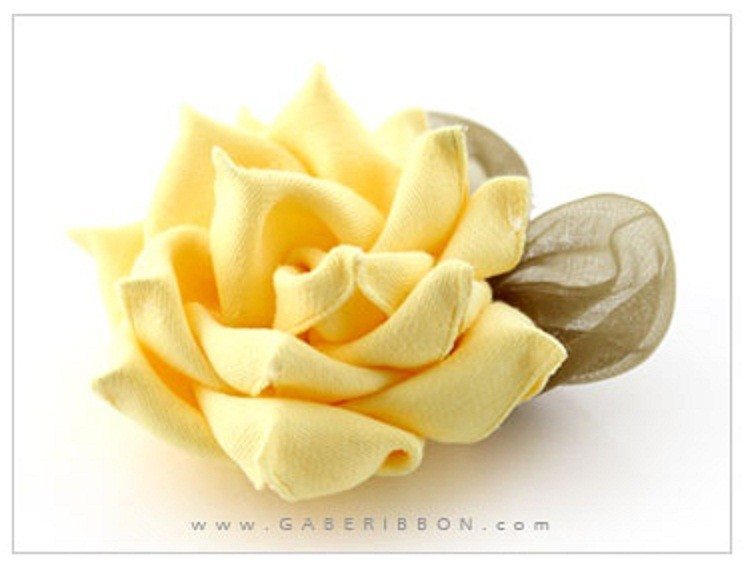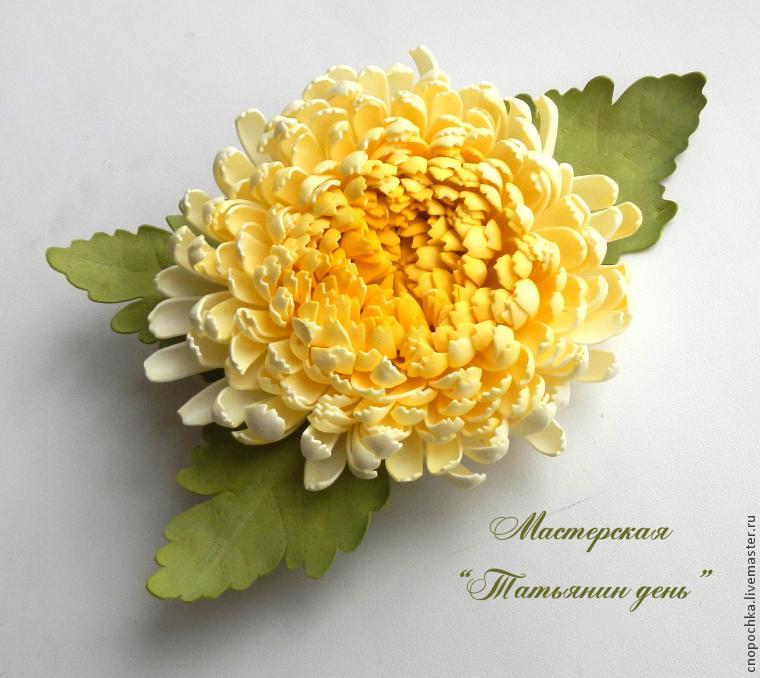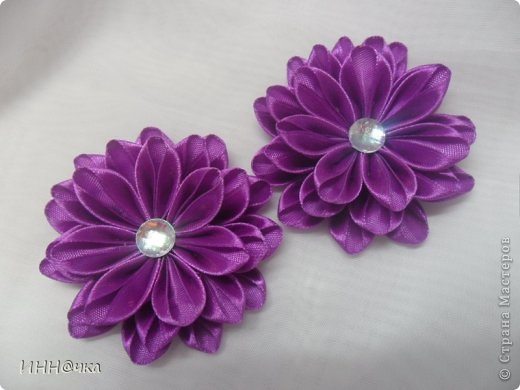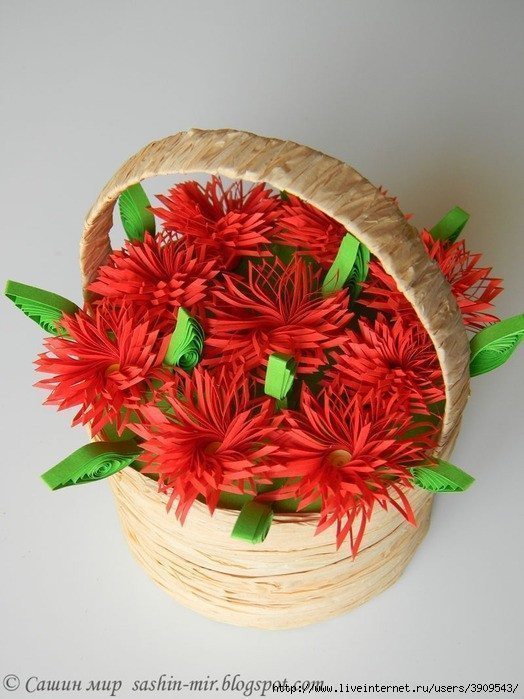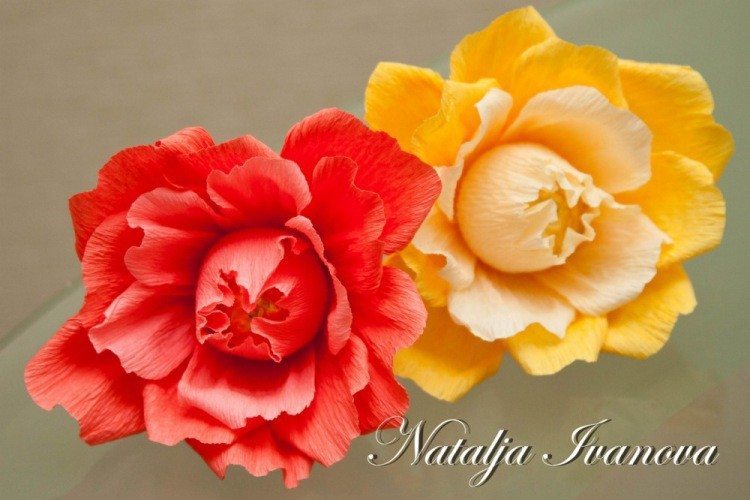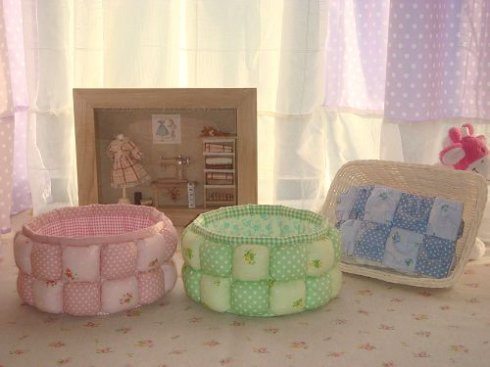
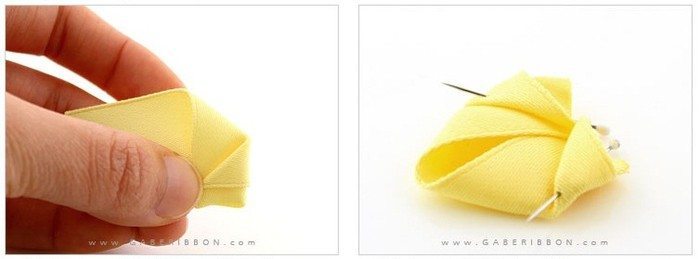
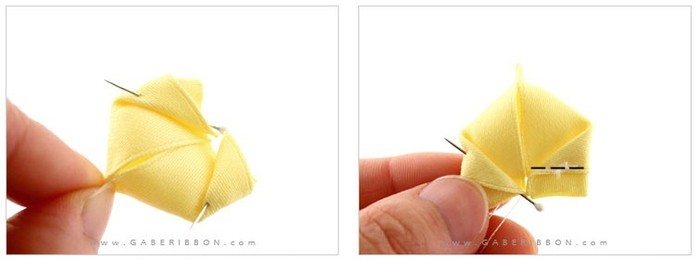
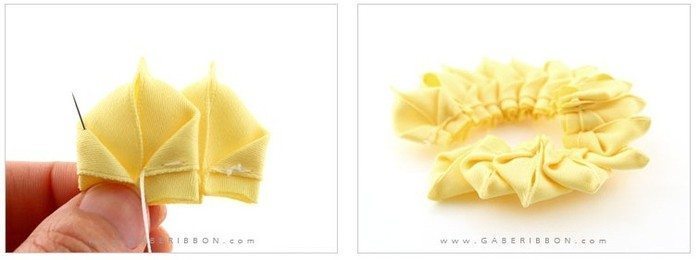

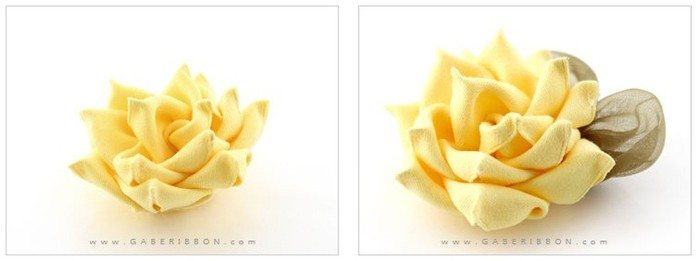

How to make a chrysanthemum
So today I will show you how to make a chrysanthemum of awesome stuff foamirana or plastic suede.
Required Material:
- Pastel dry, in my case, two shades of yellow and green.
- Scissors ordinary scissors with pointed tips, and you can take scissors and curly stationery knife.
- Wire and teip tape or floral wire.
- Glue gun and superglue.
- Foil.
- Wet wipes.
- Basis for brooches or hairpins.
- Iron.
- Stacks or improvised materials (thin brush, hook or knitting needle).
- Toothpick.
- Patience, as the petals of more than 300 pieces.

Print out the pattern. Transferred to the paper size separately each petals encircle and cut. Copy only the left half of the circle III to VII numbers of petals. Apply a template to a brighter foamiranu and draw out a toothpick (or a sharp stick, or NEpishushey handle). Just five sizes lerestkov to 11 pc. I cut the entire petal scalloped scissors and then cut into narrow lobes. So quickly. But you can simply cut with scissors on the pattern. More light foamirana cut out a strip of 13h2 cm and two circle diameter of 4 cm and a green circle with a diameter of 6 cm. The green circle and strip incision narrow petals.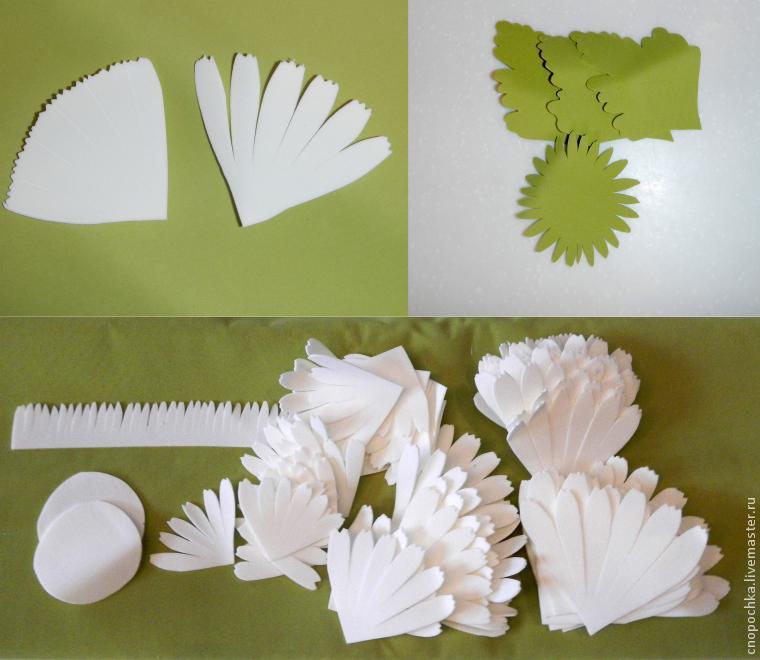
Toning petals. I picked up two yellow, dark and light. Circles, stripes and the smallest petals will be toned dark yellow. Pastel finely planed office knife, dipped into the chips damp cloth and paint petals. Petals are comfortable to hold for the area and paint from the center to the edges, unpainted area in the flower will not be seen. The next size petals toning already light yellow, but well stained. Following the petals are not so much paint, and at last a little tint tips. Green pasting little zatoniruem dark green.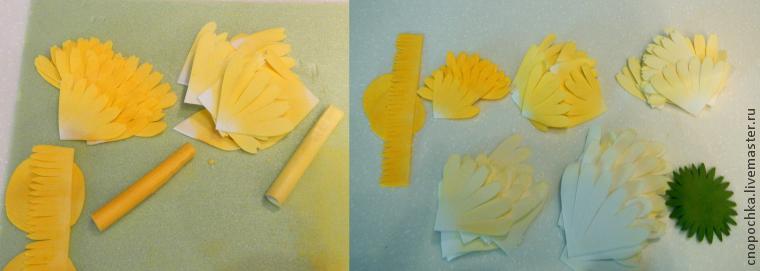
Making the veins on a leaf. If not Mold, you can simply draw a toothpick. If the MDL is, putting a piece of iron to a couple of seconds and still hot pressed to the mold. Then, the leaves can be toned dark green pastel, then veins will be more visible.
Getting modeling petals. Apply a strip to the iron, the petals themselves skukozhivayutsya little and bent inwards. Small petals is also applied to the iron, then quickly on the palm and dent stick or stacked along the petal almost to the tips to form a depression in the ground. Stack of little curls around the axis in one direction and then in another direction, pressing the tab on the palm. Then heated area and also folded the petals inside it. And so four sizes of petals.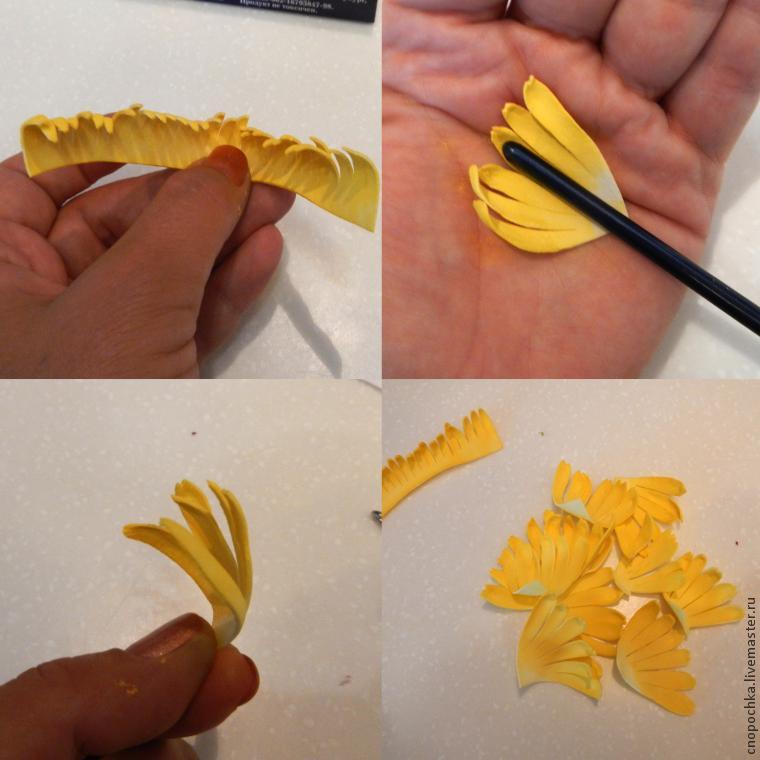
Biggest heat the petals not entirely, and by parts. Stronger drive stack from side to side, thereby thinning petal. Then add up each individual lepestochek half and carefully stretch the fold place, thus giving him a convex shape. Heat the corner, tuck into a petal. Green pasting also apply to iron and slightly twist the ends of your fingers.
Cut a piece of wire, make a loop on the end and stick to it a piece of foil. Foil rammed into a ball with a diameter of 2 cm. Heat the Melt. One of the yellow circle and glue smear middle of the circle to the ball, a little stretching. Cut a circle in the corners and glue the remaining pieces to the ball of foil. With the next yellow circle Do the same. It turns ball pasted two layers foamirana.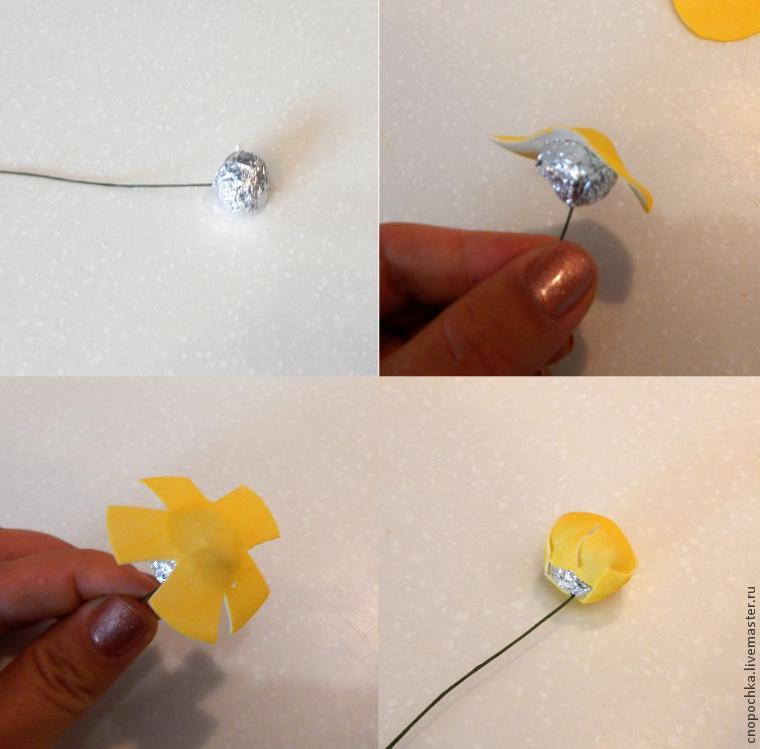
Take scissors with sharp edges and very carefully cut the top layer of a small corner. Then take a strip with petals and start to stick her in the middle of the ball, so that the edges of the petals converge at the top. Striped wrap twice around the ball, gradually podkleivaya glue. Middle, turned the flower.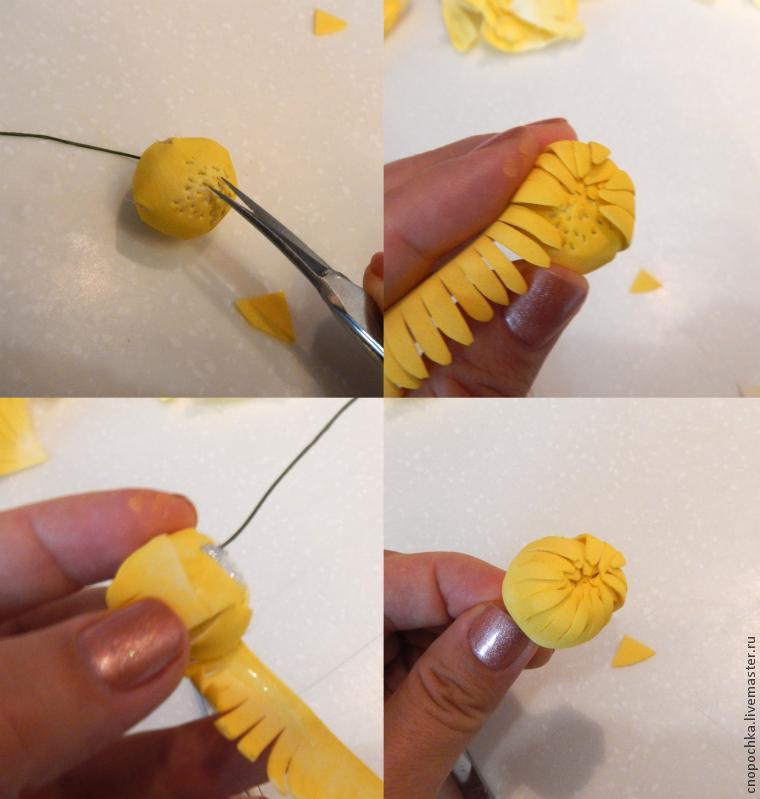
Take the smallest petals, first try on them on top of the flower, retreating from the previous row by 1mm. Hold onto the hand turn over the ball, turn down corner and glue the petal from the corner to the middle of the petals, so he stuck to the edge of the strip in the previous row. Next petal glue around the circle, making the overlap on one small lepestochek. And so on.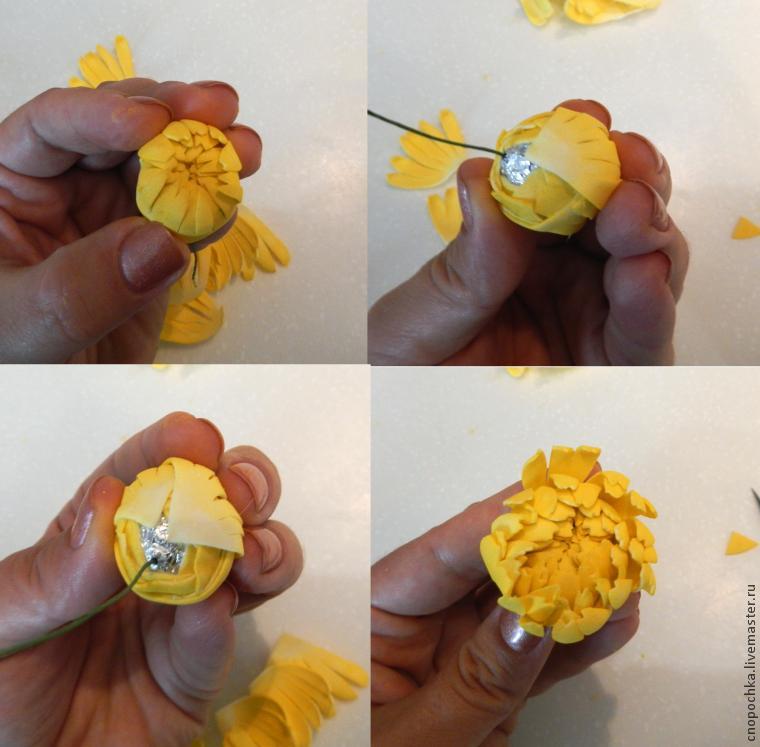
Continue to glue the petals, just aligning the tips first, shifting them from the centre 1 mm and forming a tip, and then glue the bottom corner just a petal. And so, until all the petals are completed. Cut the wire close to the flower and green glue pasting, closing the lower part of the flower.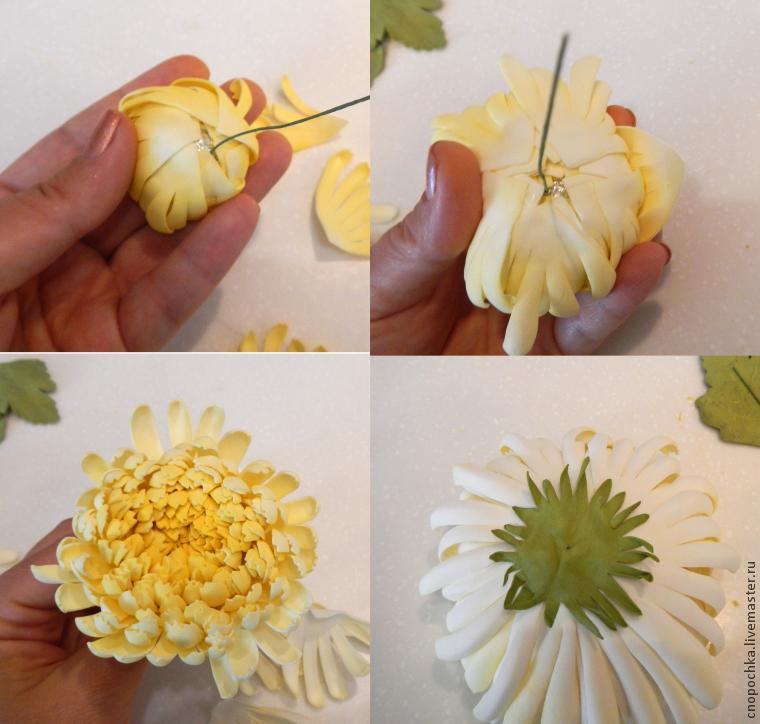
Middle leaves from the back side glue pieces of wire 10 cm long. If there is no floral wire, you can take an ordinary thin wire and wrap teip-tape. Careful turns stick with superglue. Then coated with glue and wire edge is glued to the leaves of the flower. The final stage – we take a basis for brooches or pins, I have a universal, well we coat it with glue from Melt and glued to the bottom of the flower.
That’s all. You can wear it! I wish you the autumn, full of love, warm colours and the smell of carnations …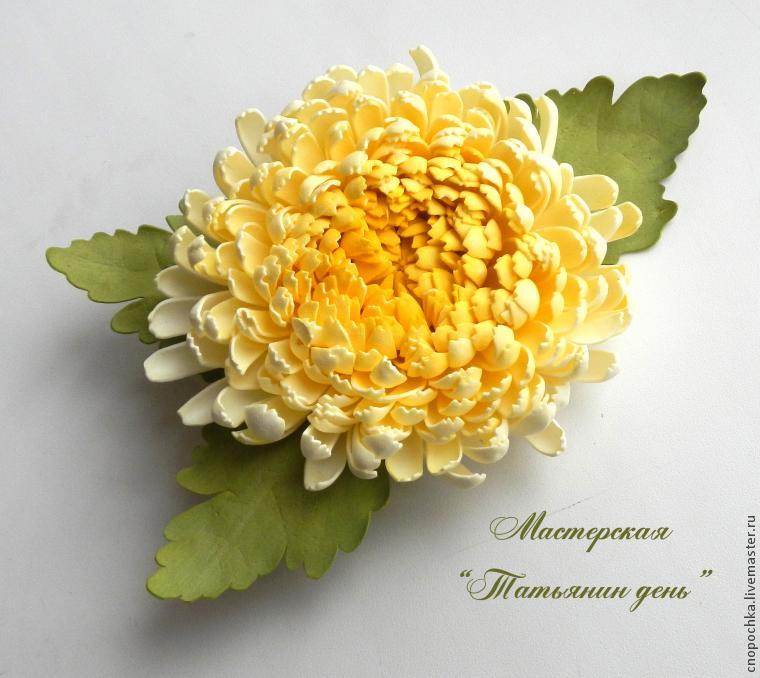
DIY Recycled Newspaper Craft Handbags Making Tutorial
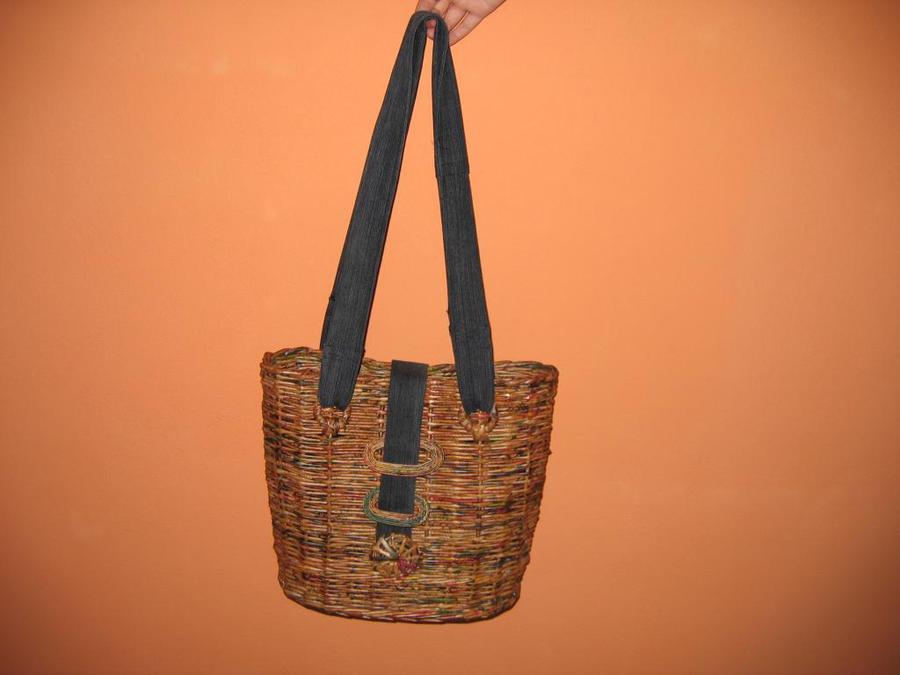
Make a small collection of bags from newspapers, very much I like them!
Recently, I was eager to weave something for yourself. Decided: let it be the bag! In search of inspiration, as always turn to the Internet. And found a great variety of options wicker bags, baskets and other things. That’s decided to share my findings with you, all of a sudden someone also need inspiration. To start with different bags, woven from various materials to awaken the imagination.
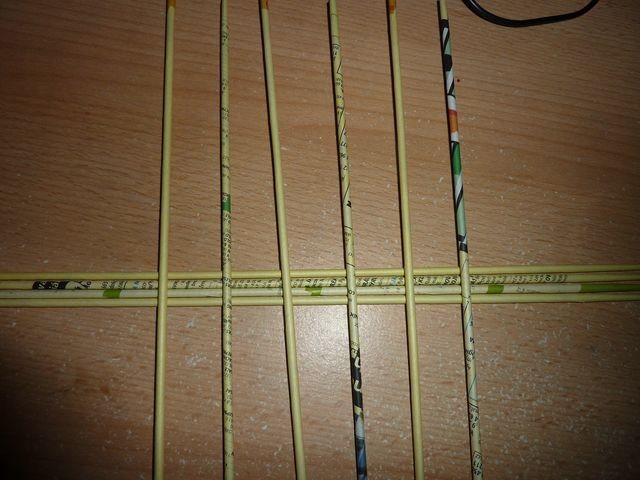


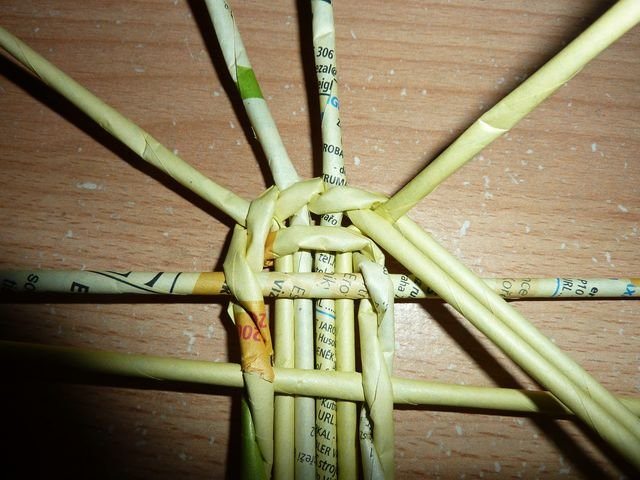
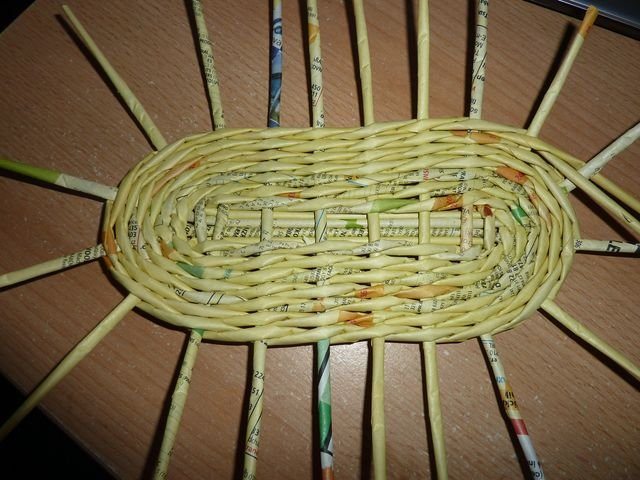

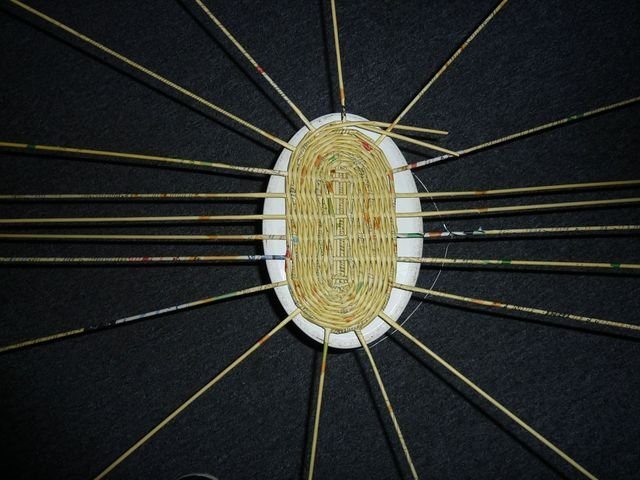


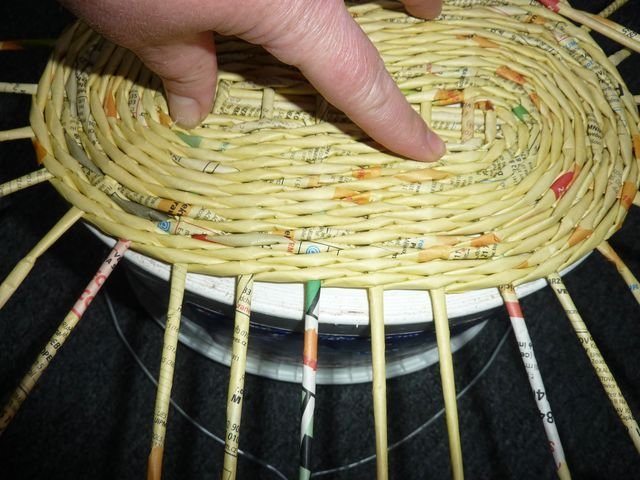
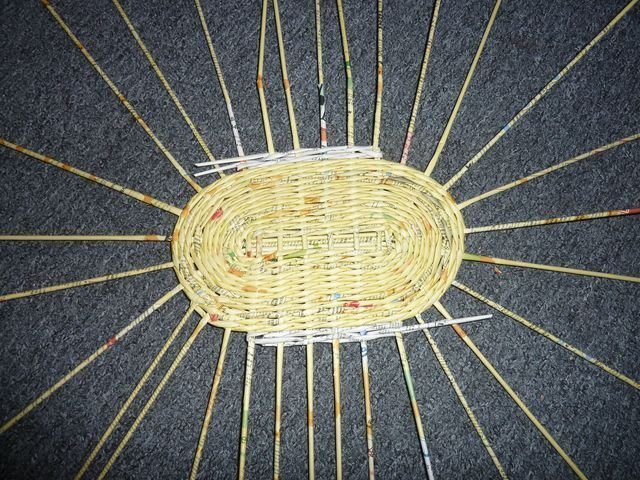

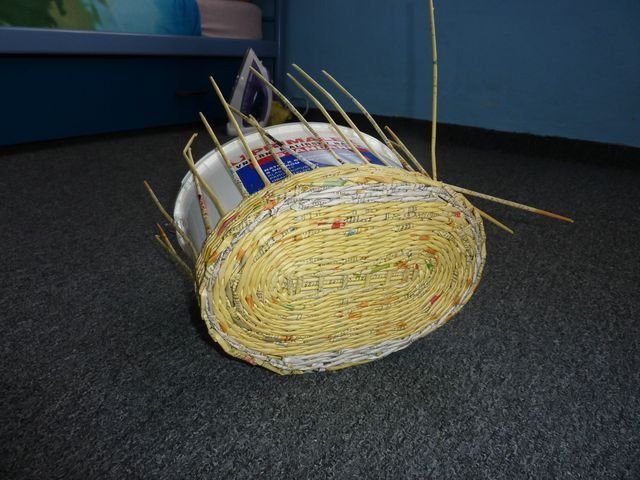
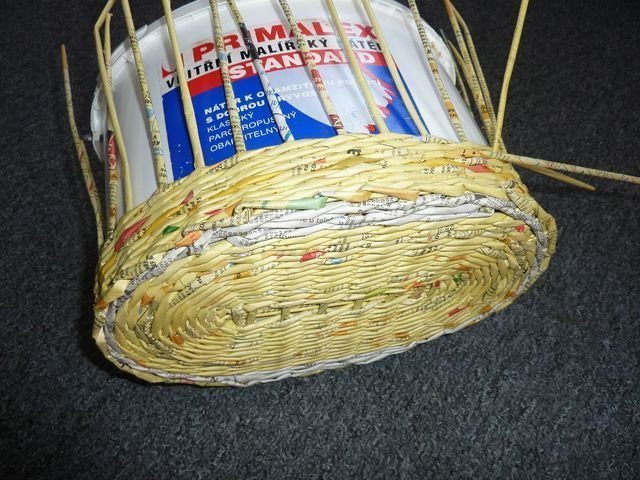

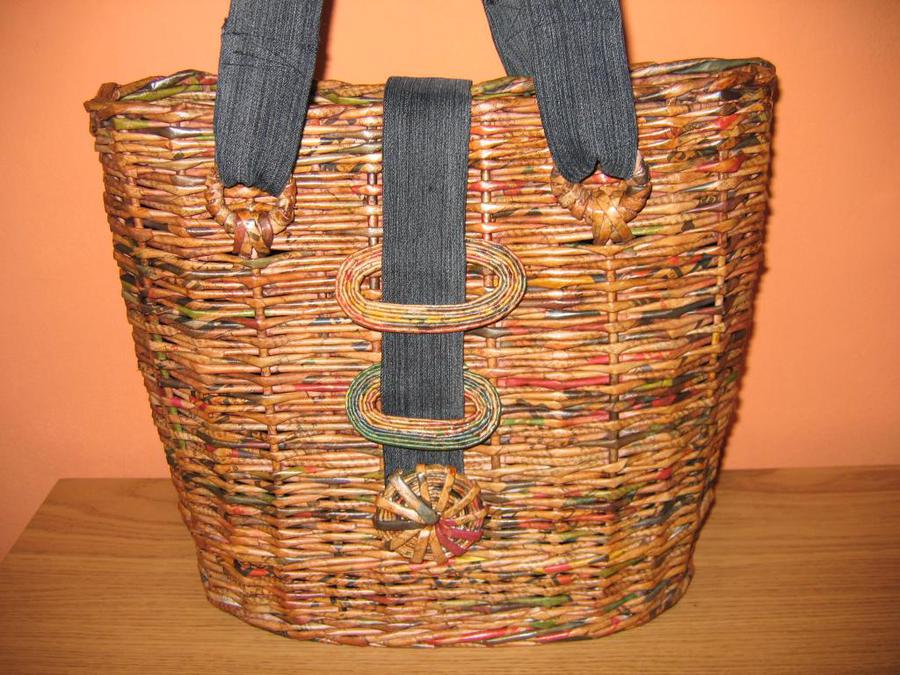


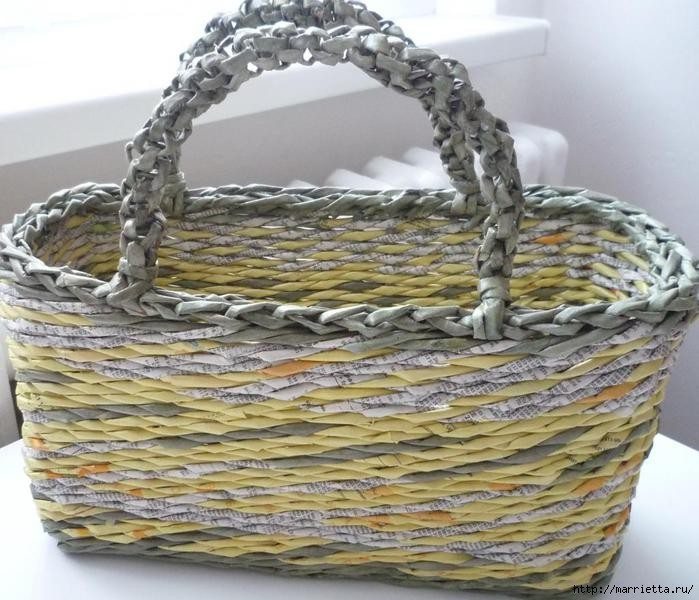
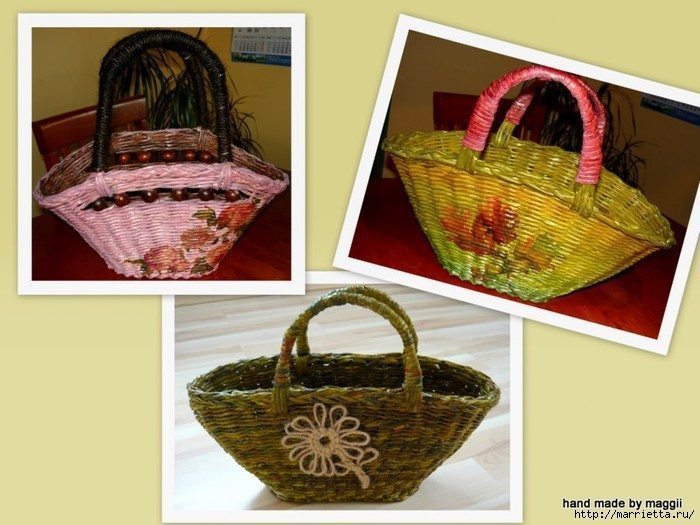
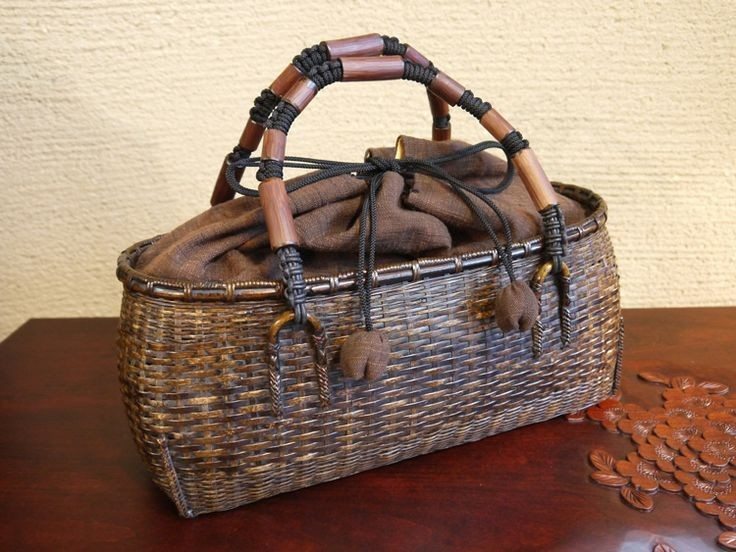
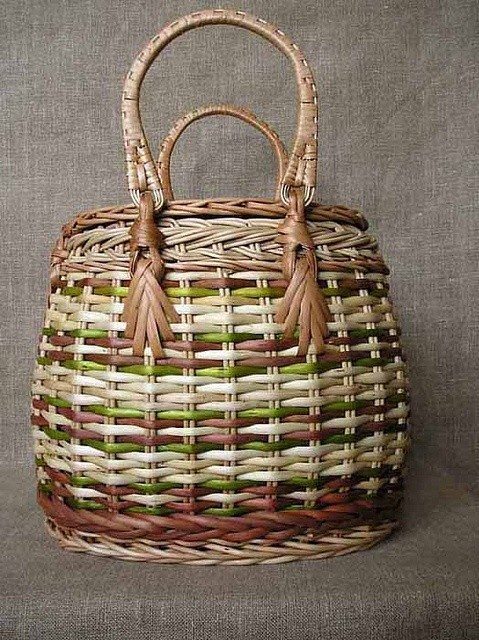

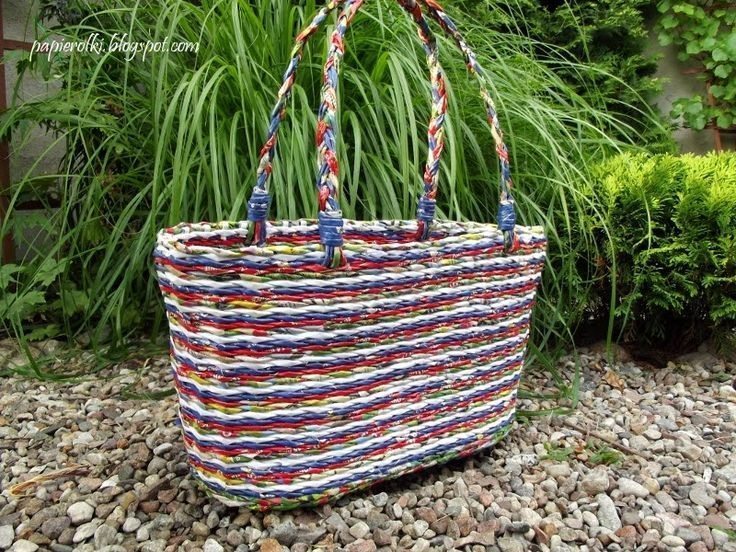
Beautiful Ribbon Flower
Well then, so we take the tape width of 2.5 cm .. do work piece 5 cm .. Their number depends on the size florets. 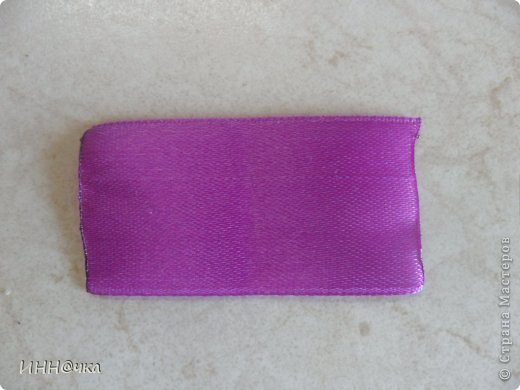
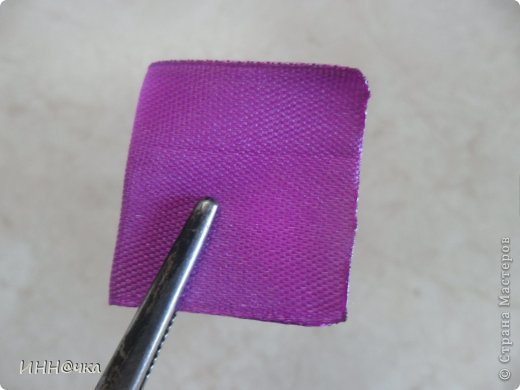

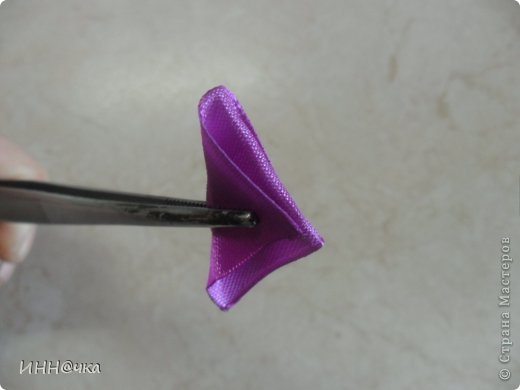

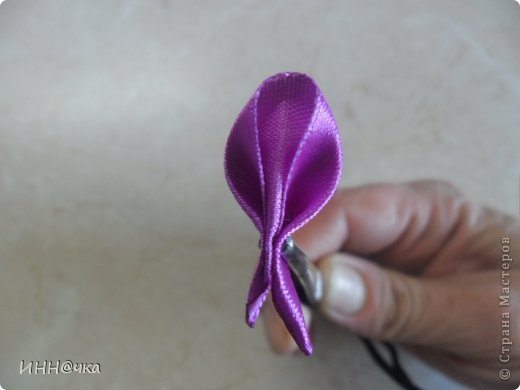
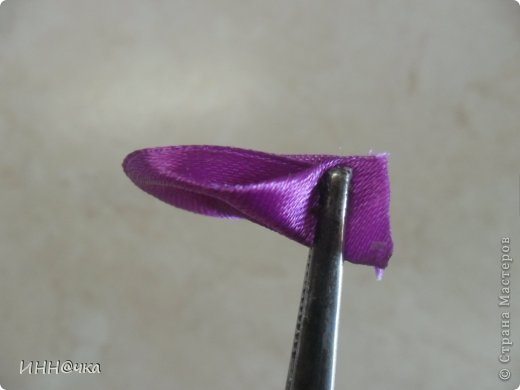
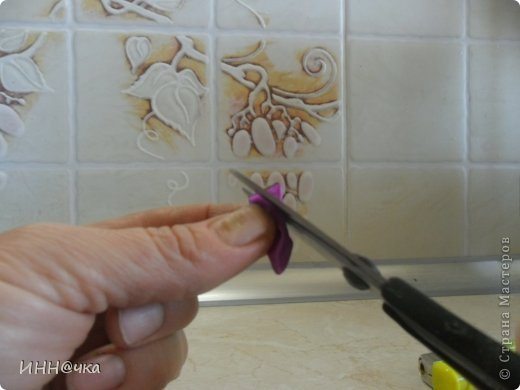
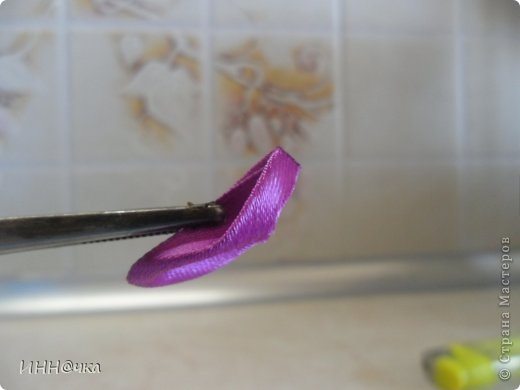
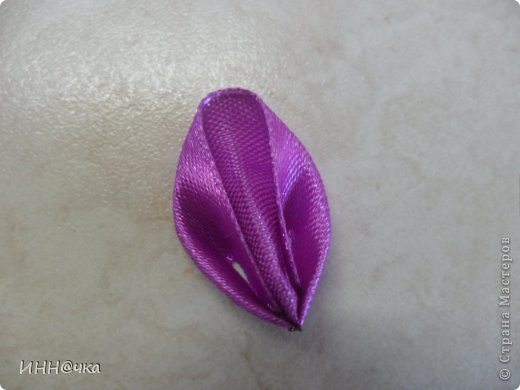
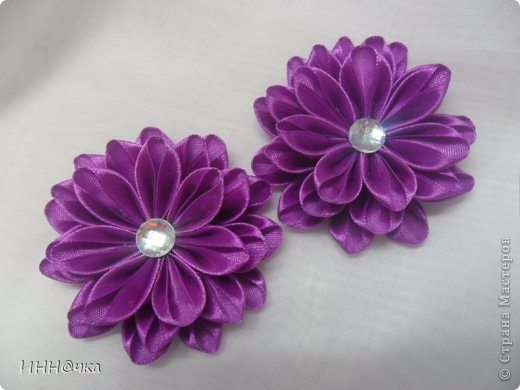
Beautiful Weave Mandala
I invite you to an entertaining lesson in the manufacture of Indian mandalas. We try to make decorative eight pointed Indian mandala made of wool and wooden sticks. Sit back, turn off the TV and radio, and supplies should be: arm rests, four sticks (I took the rod 25 cm long and 6 mm in diameter), a pair of scissors. More we do not need.

Putting two sticks together and bind them firmly in the middle of a double knot. Leave a small tail, which in the process will go under the braid.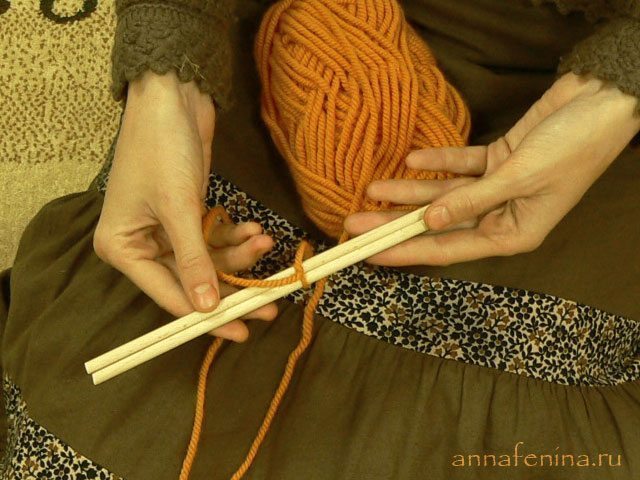
Deploy sticks so that they form a straight cross. Be careful and make sure that the angle between the rods remained 90 degrees in the process of weaving. We fix sticks tightly wrapping them 6-7 times obliquely, first on one diagonal, then on the second. Check that the cross durable and sticks it move not.
And now begins the thread braid in a circle each stick. Draping string top, makes a complete revolution around the sticks, and when the thread once again be on top, toss it to the next stick. Do not forget the uniform tension. Scourge until you see what happens square. Make it as large a wish.
When you decide what size square enough, cut the thread with a small margin and tie it around that sticks, which begins with a square weave usually single node. On wooden sticks even a single node is kept pretty tight.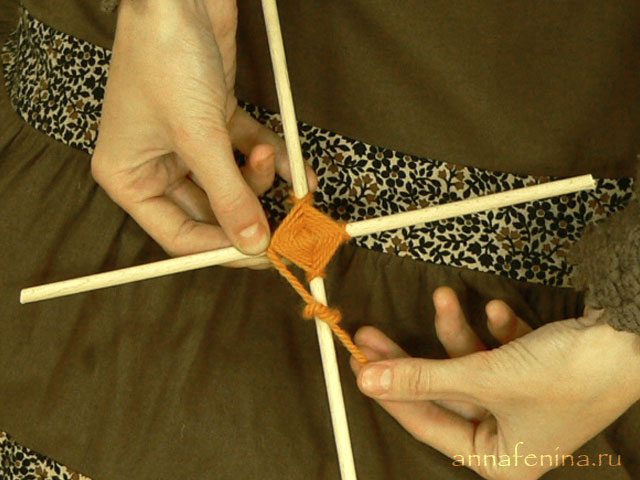
Then bind to the same or another stick thread of another color, leaving a small ponytail. And new colors start to move around again. When you get to the first rod, let under the braided ponytail remained there, after his little pulling. Let them do everything under the braided ponytails that will remain with you in the process of weaving.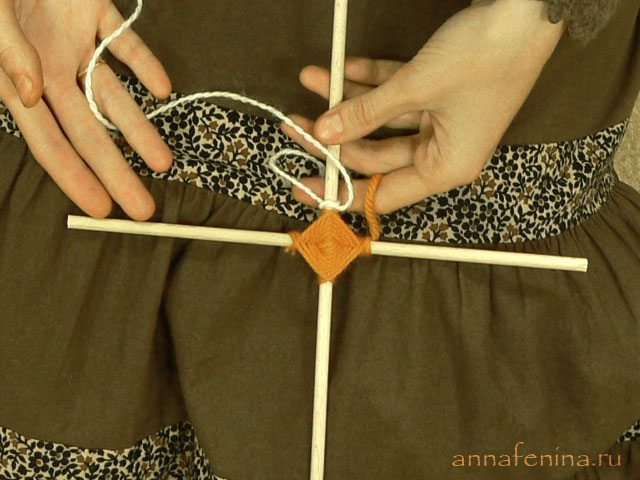
When finished weaving a second color, fasten thread. The most simple – tie her with residual tail double knot.However, complex mandala, for example, shaped or therapeutic trudge all with just one unit – and the one at the end. And not a drop of glue!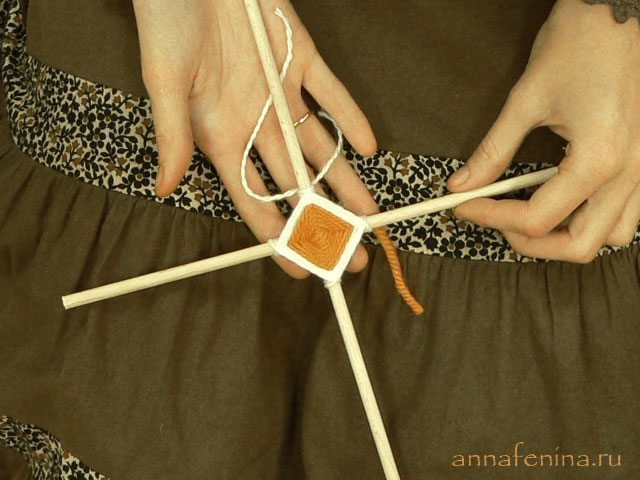
And then the gossip the same square on the remaining two sticks. There is enough of the same color: it is barely visible in the mandala. The size should be exactly the same as the size of the first square or a few millimeters larger it.
The first step has been taken. Ahead – the most difficult: the socket. Rosette – a small sun, which is obtained at the beginning of weaving mandala and the quality of which depends on its strength and quality. Put two squares at each other evenly sticks and tie a string to one of the rods of the lower square.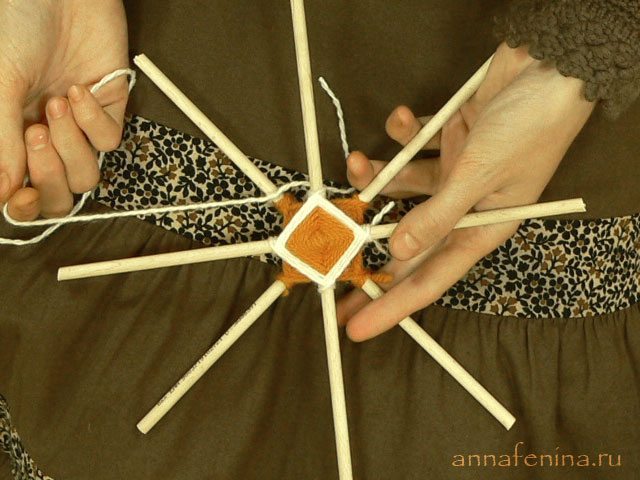
Getting braid sticks thread THROUGH TWO. That is, the thread passes under the mandala, grabs a stick from the previous two, revolves, and again goes under the mandala to the next stick in two. Initially, the mandala can not hear, “walk”. Your task – to make a full circle, back to where started, after which the correct squares to each other in all planes. Make as many laps as you want, but do not forget during the weaving sticks correct relative to each other in all planes.
Here’s how it will look from the inside. Pattern, which is obtained by weaving “two” is called “rays”. And all of this composition – the socket. When finished weave this color fasten thread.
Tie to stick color and begin to weave them.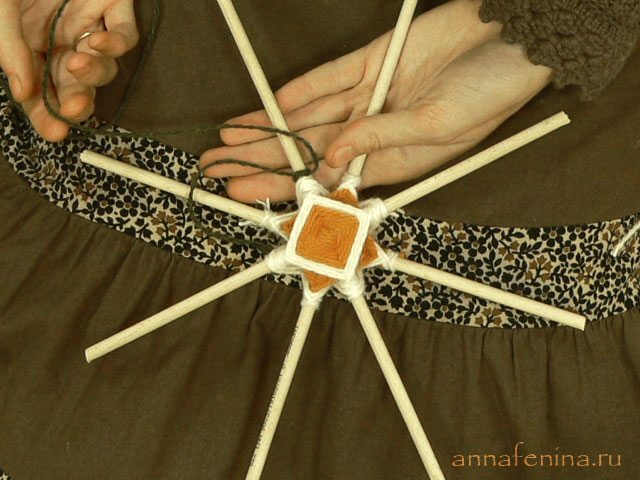
On the reverse side will be obtained this way. After finishing a dark green color, I wove a few rows of light green.You can use as many colors as you want.
We prepared socket – the hardest thing in the entire mandala. Now proceed to the relaxed side netting – a square.Squares weave, almost like rays through only one stick. It turns out that we weave is square on the top cross, then on the bottom, as in the beginning. Tie one of the rods of the lower square thread of the new color and begin to weave through a wand. Finished color – fasten the thread knot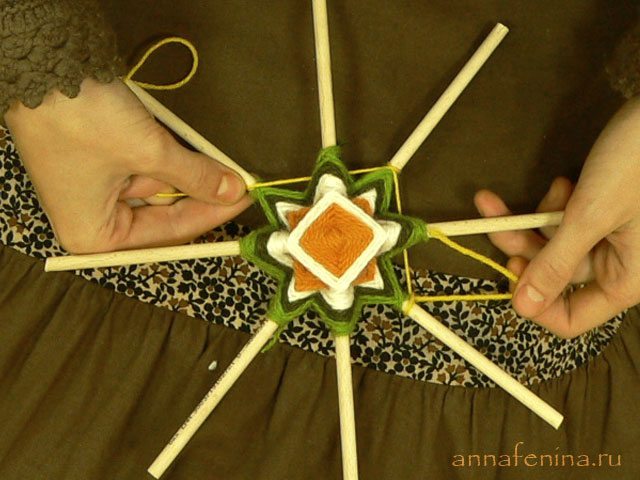
Weave square exactly the same width, but on the upper cross. Can choose a different color.
We starting to get here is such a beautiful flower.
Add a couple of squares of different colors. I decided to stay at the purple, but you can add more colors.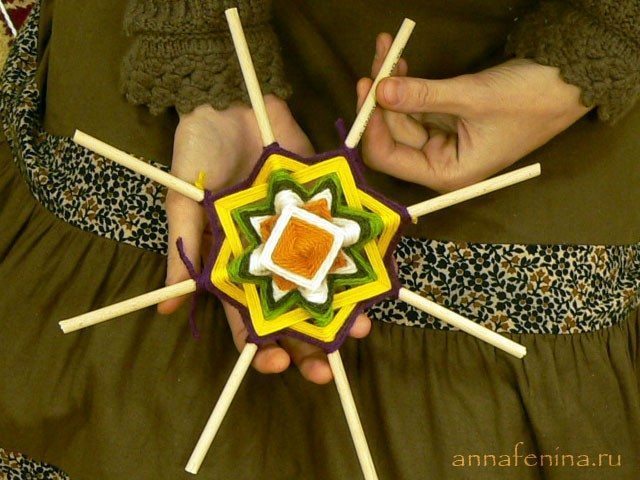

Add more flowers as you see fit, but be sure to leave at least one-quarter of sticks to weave them the final element of the mandala – a belt.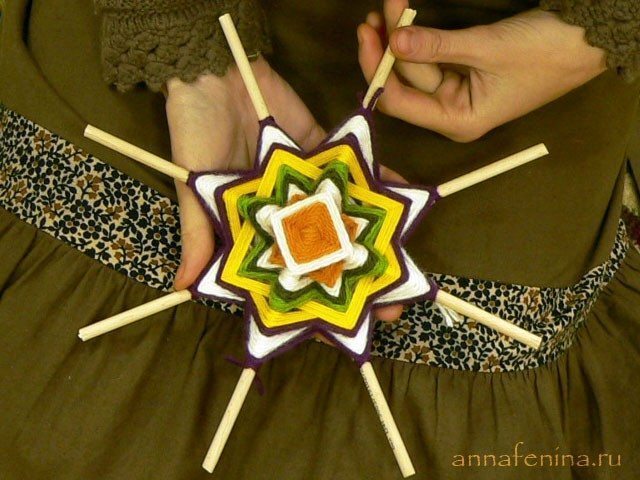
Wrong Side of the mandala.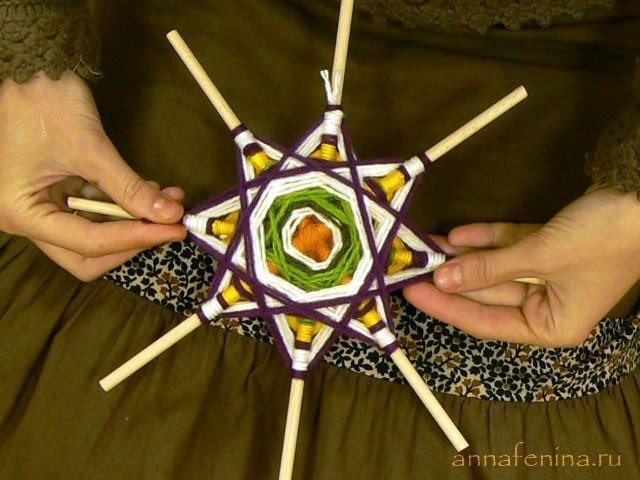 Getting Chain Belt. Tie a string to a stick, and any sequence begins braid sticks around. This is perhaps the easiest of the mandala patterns.
Getting Chain Belt. Tie a string to a stick, and any sequence begins braid sticks around. This is perhaps the easiest of the mandala patterns.
Finish one color, skip to the next. After several rows of light green, I added a row of blue and completed times are dark green.
Well, the last fixing pattern. We stayed neopletennye ends about an inch long sticks. Tie one of the sticks thread, kototoraya will complete color chord in the mandala.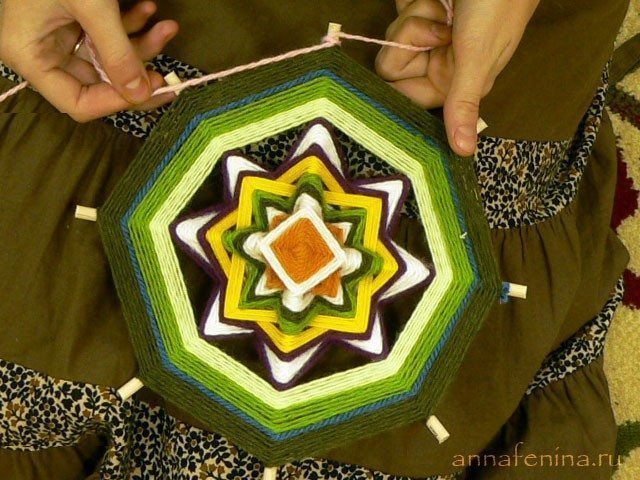
It will be a kind of belt in a row. Loop the thread to the next stick and wrap it to the end, up to the top and then back down to the bottom and wrap the thread perekin’te further.
Going round the circle completely and shook the ends of rods, tie a string to the tail of the same color and make the tails of the loop.
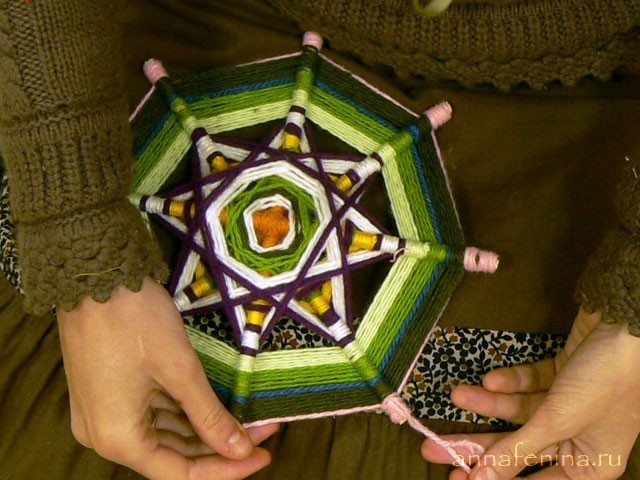
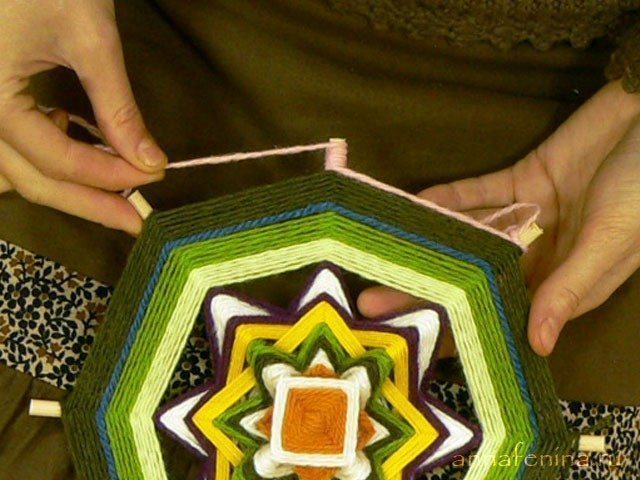
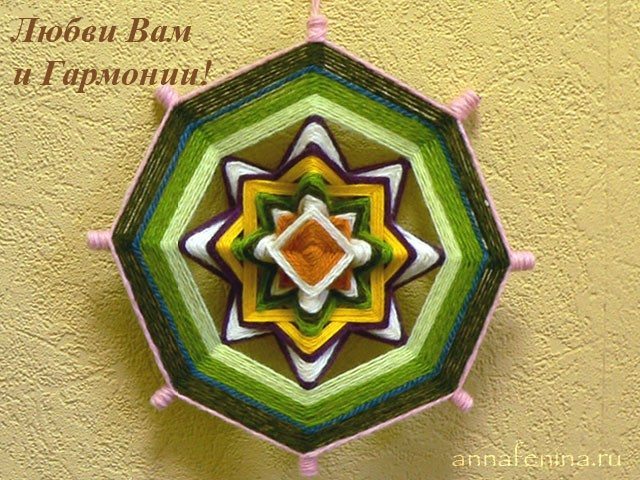
Beautiful Spring Basket
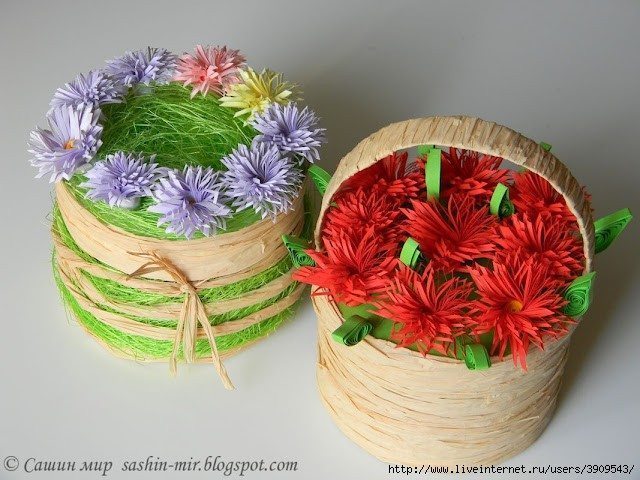
Required Material:
- spools of wide adhesive tape
- double sided tape (thin)
- artificial grass
- cardboard
- green paper
- scissors
- thin strip of soft plastic (for pen)
- manicure tool or a pen
- pencil
- strips of palm leaves for decoration
- Melt
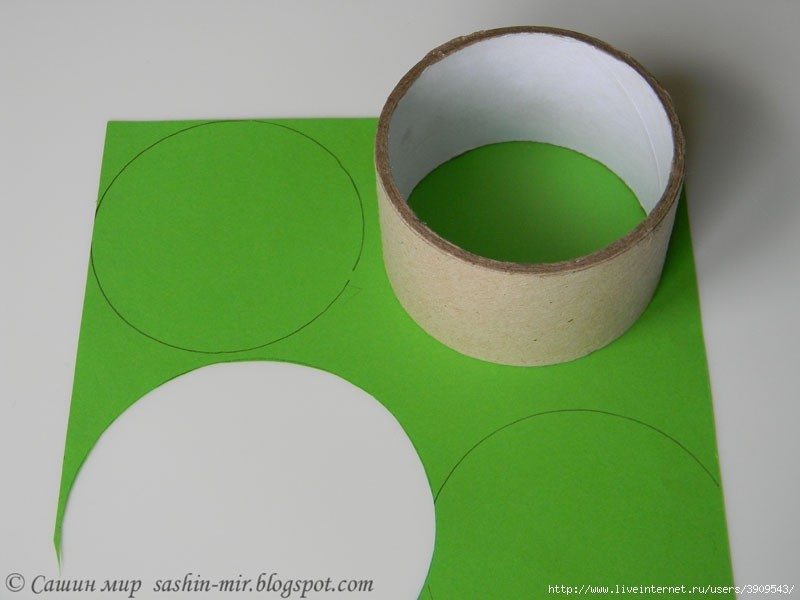
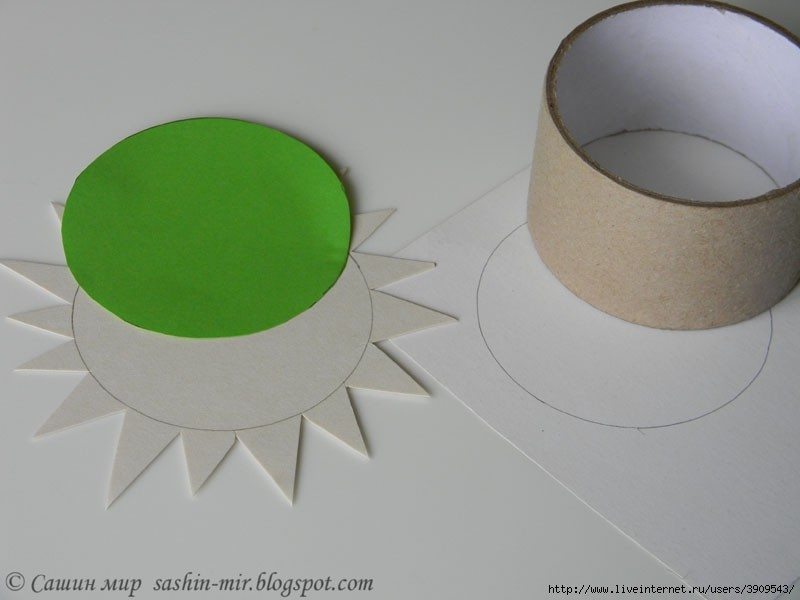

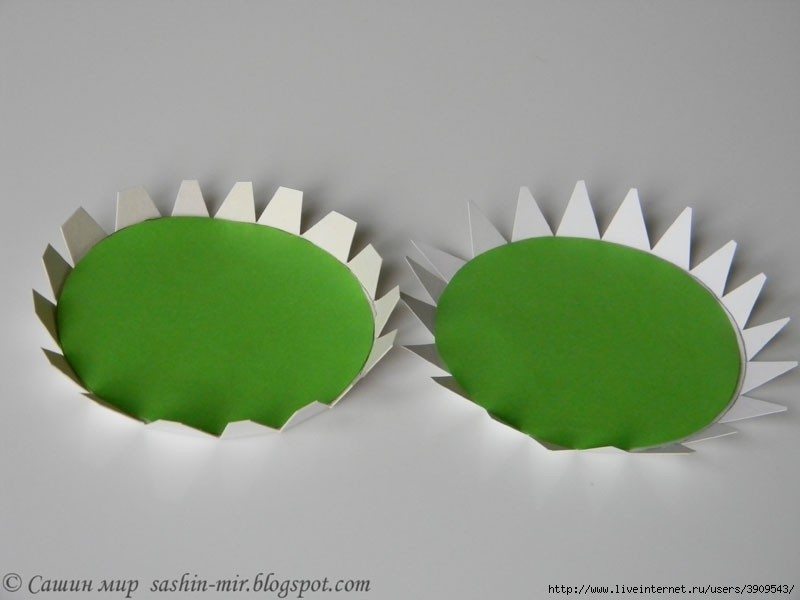
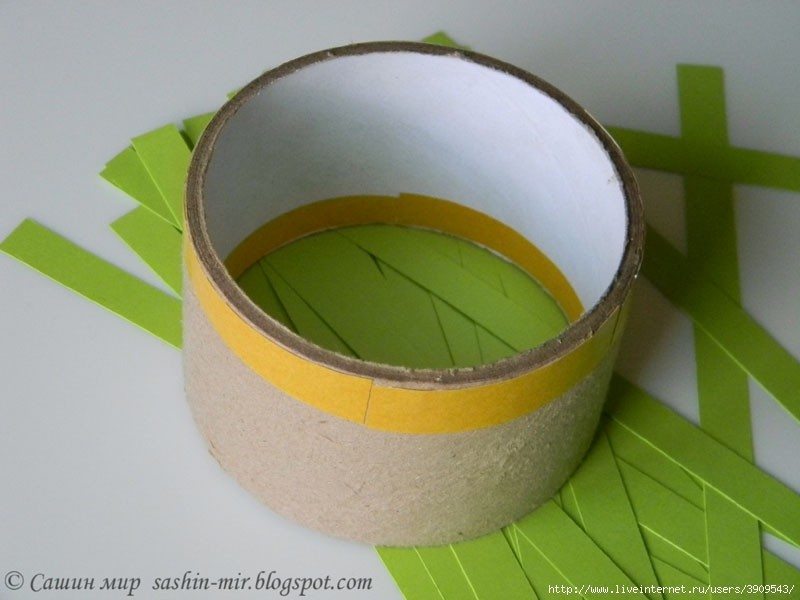


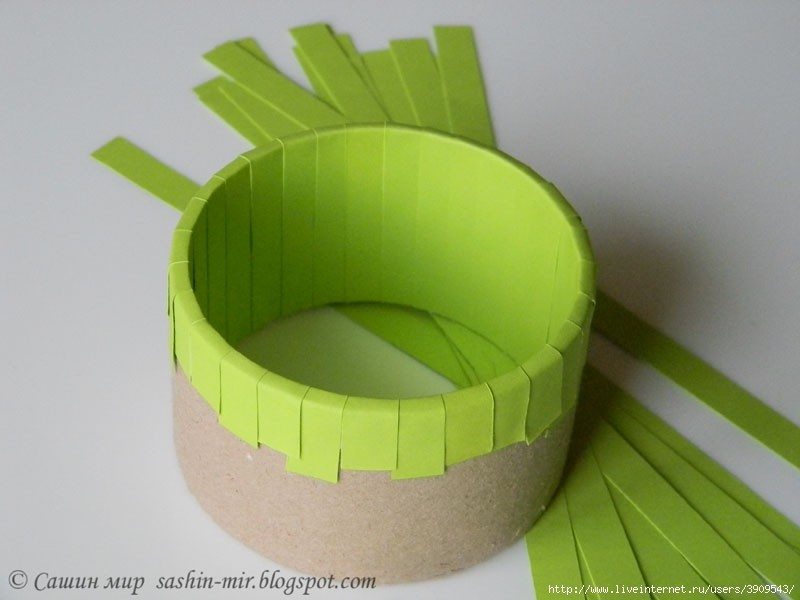
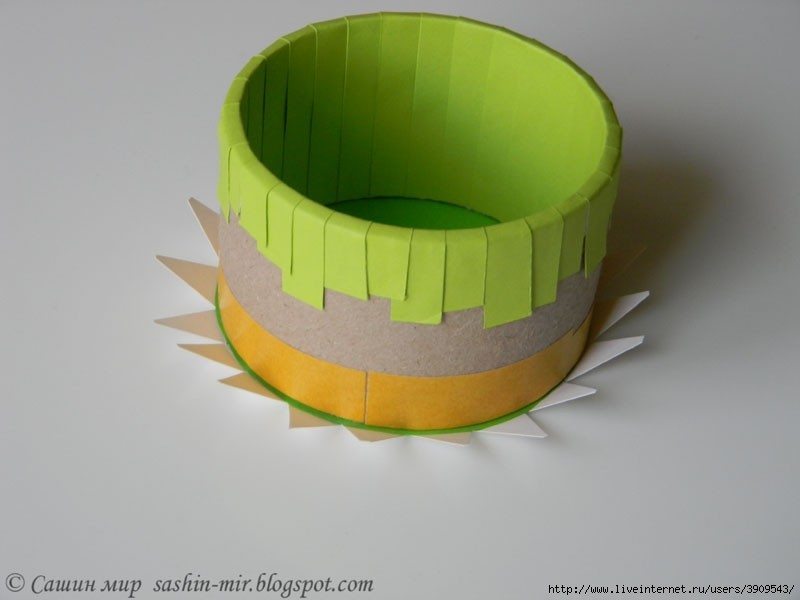
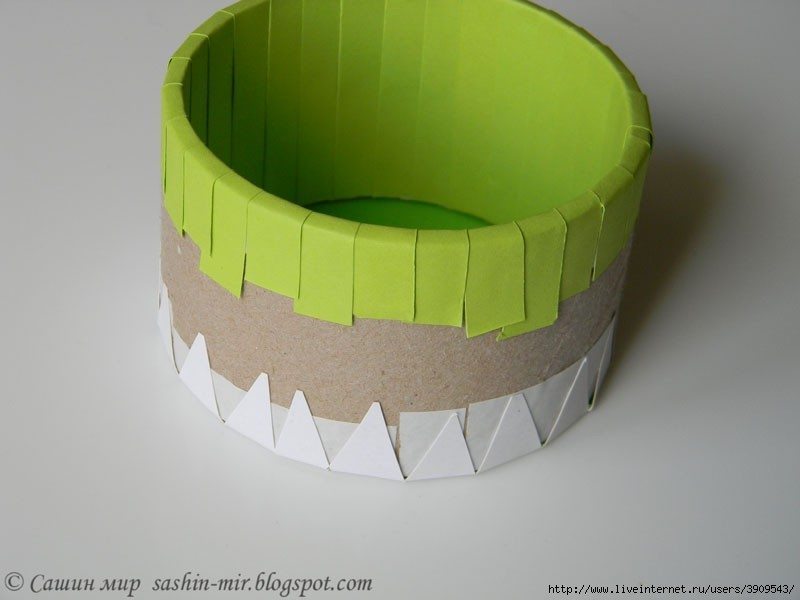
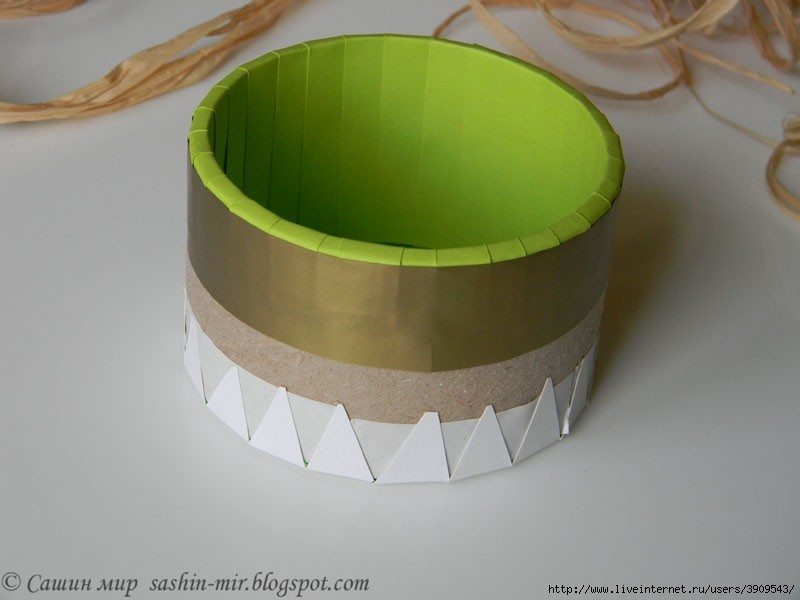
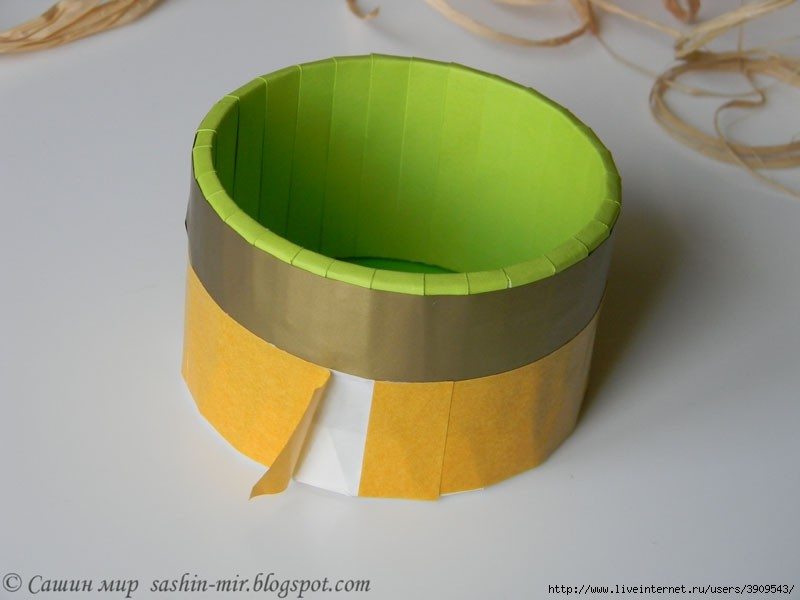

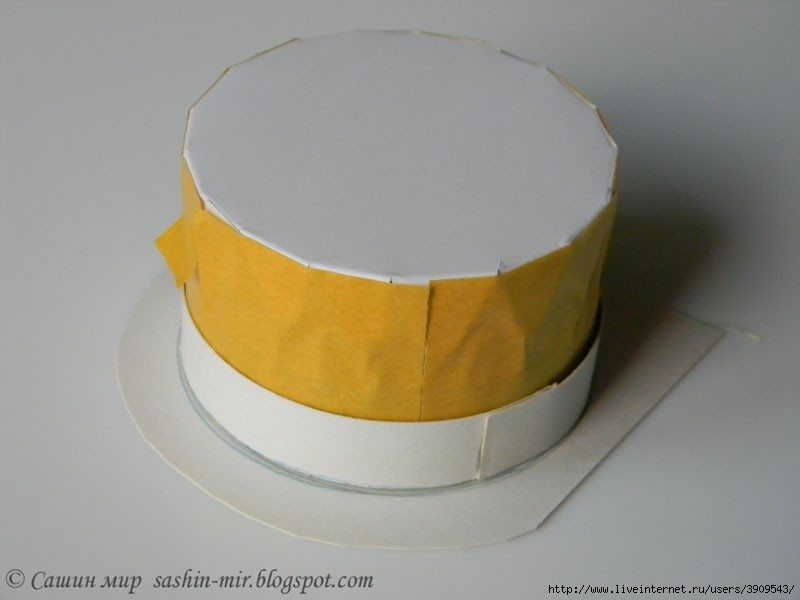
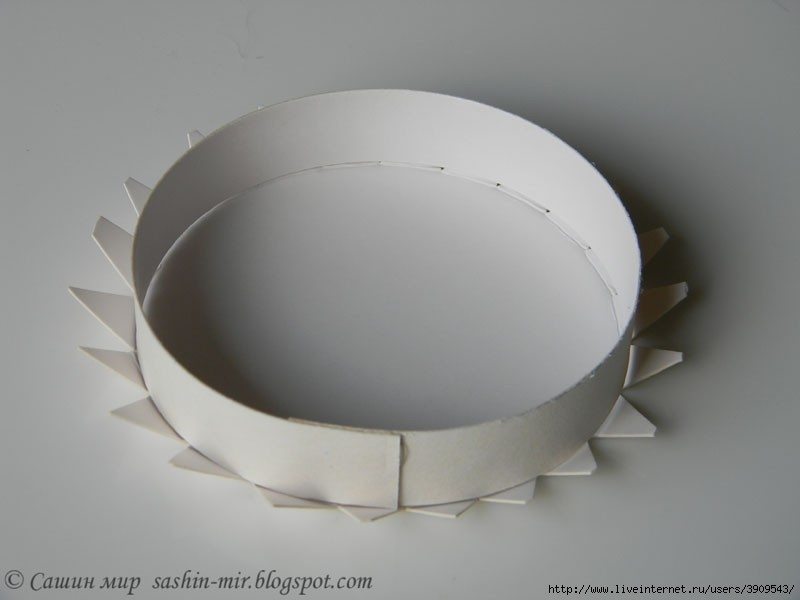

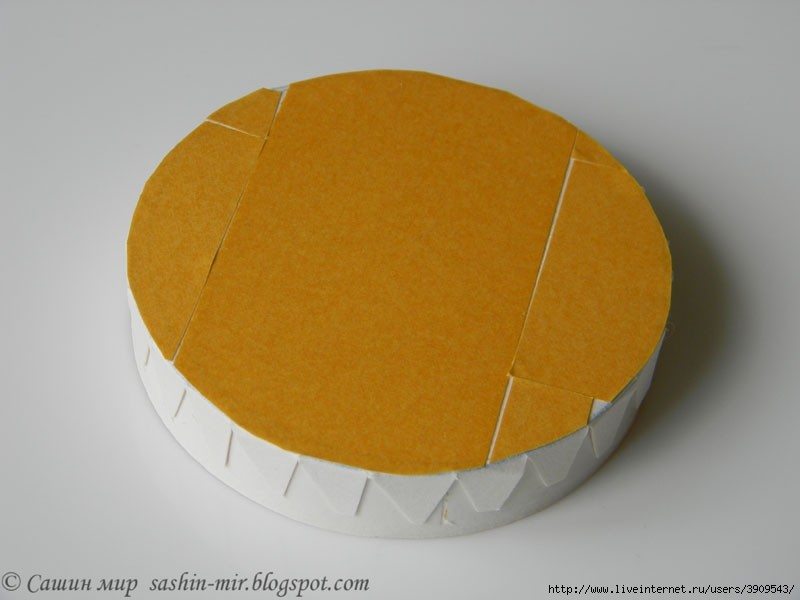

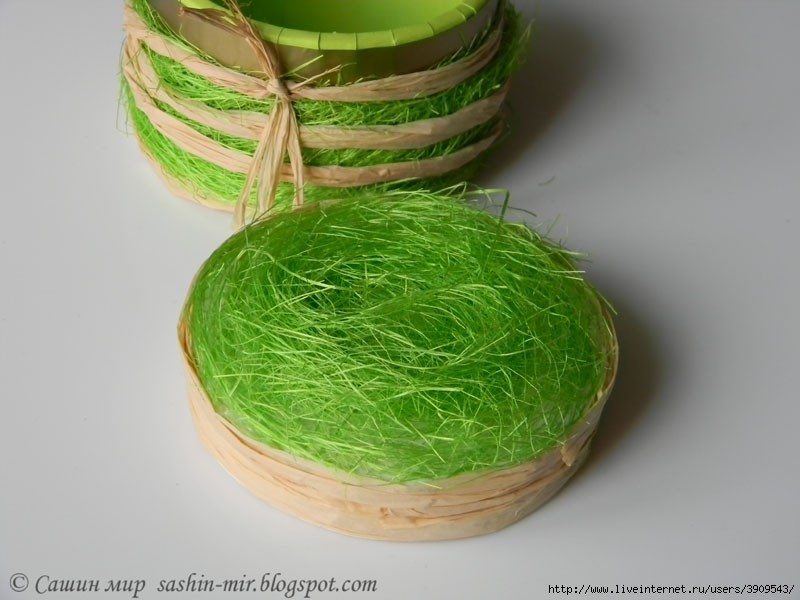
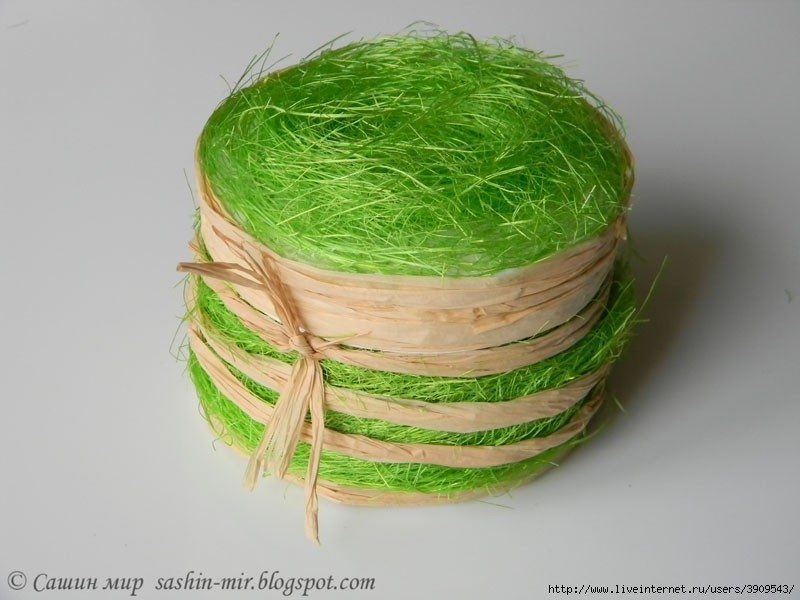
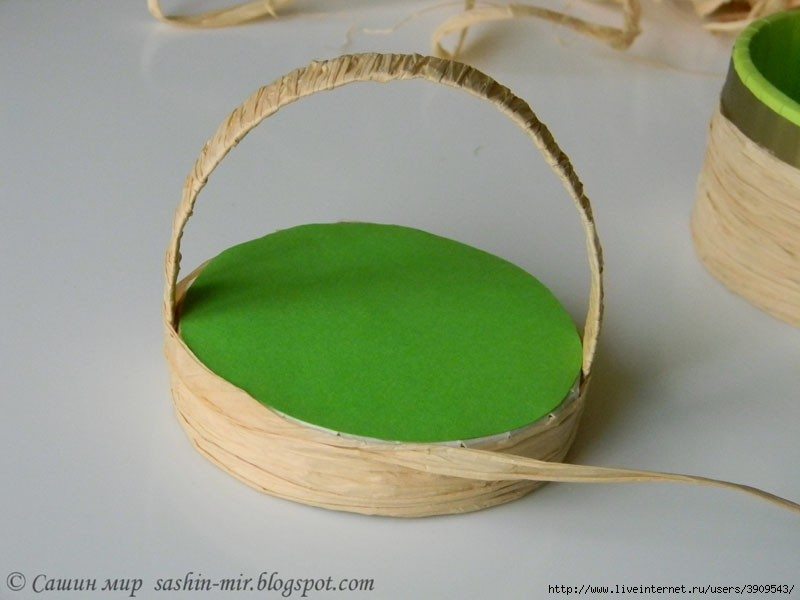
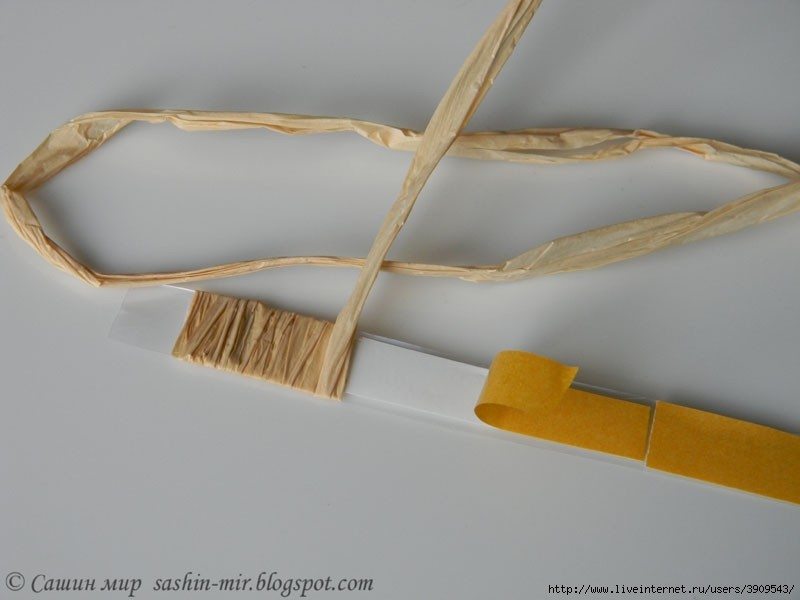


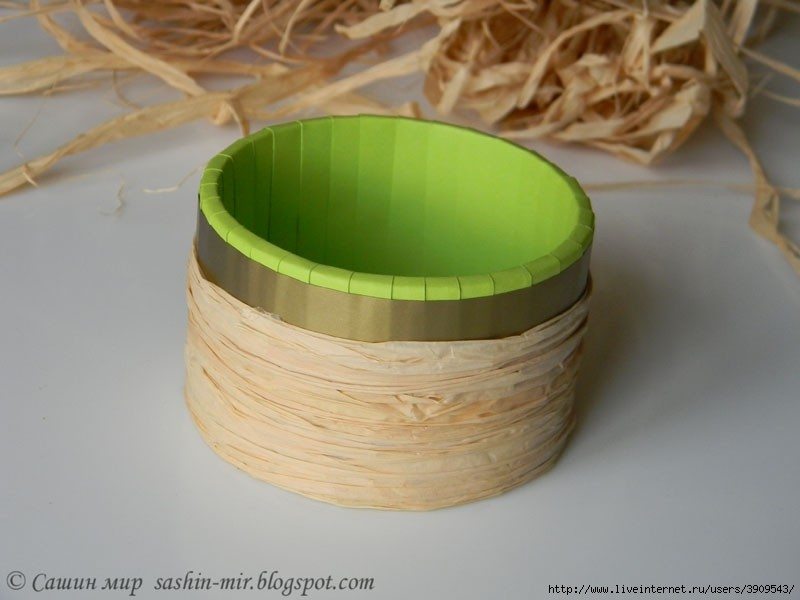

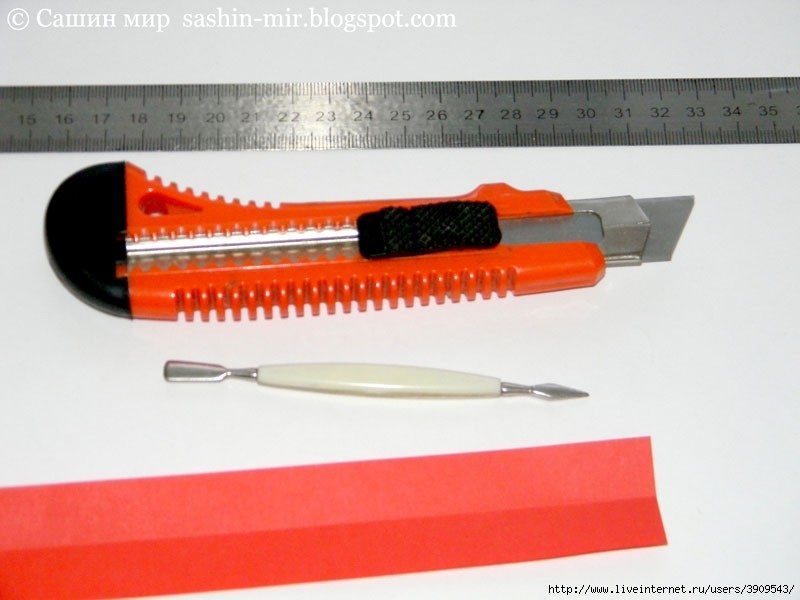
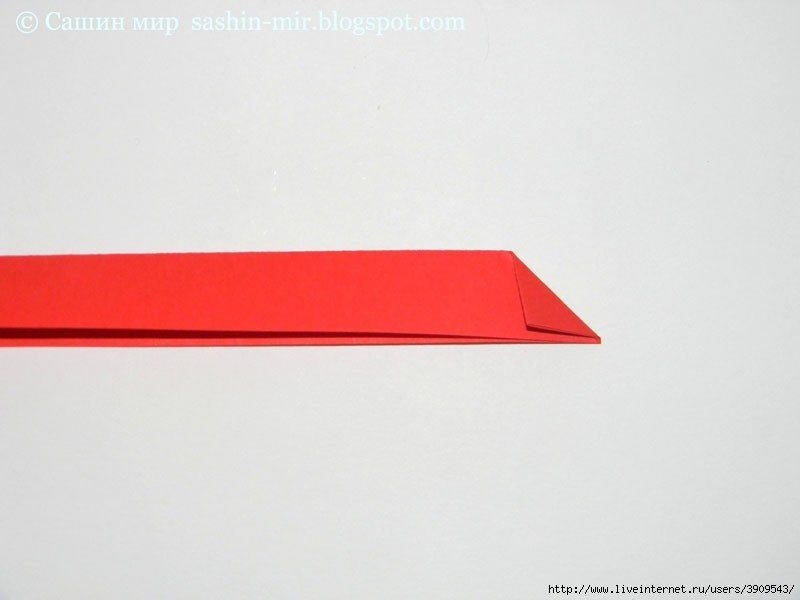




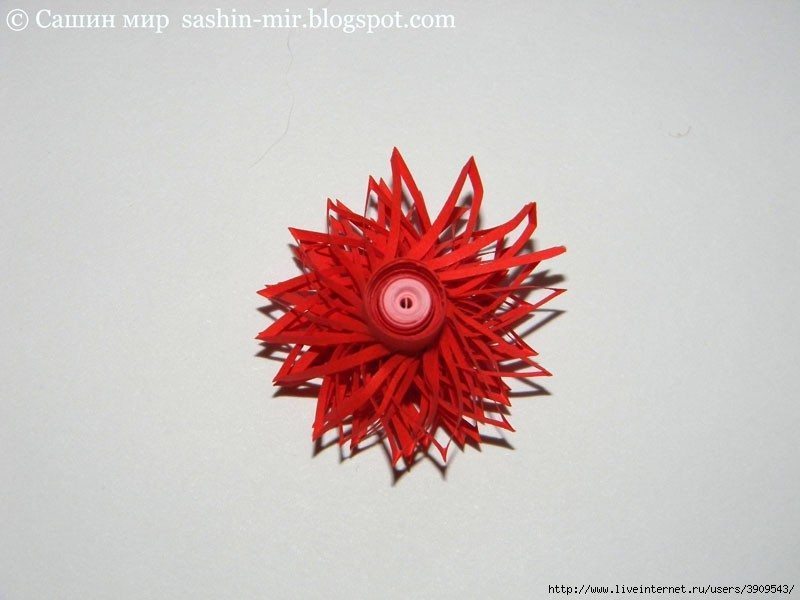

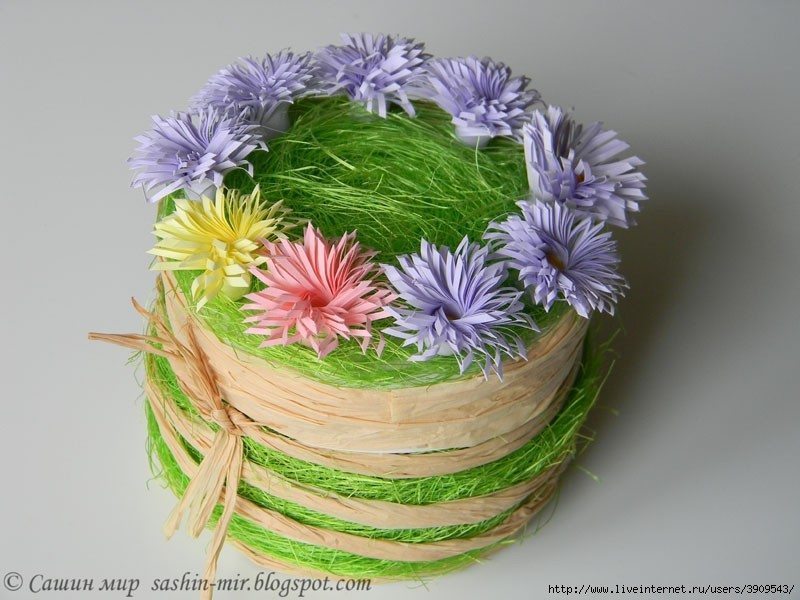
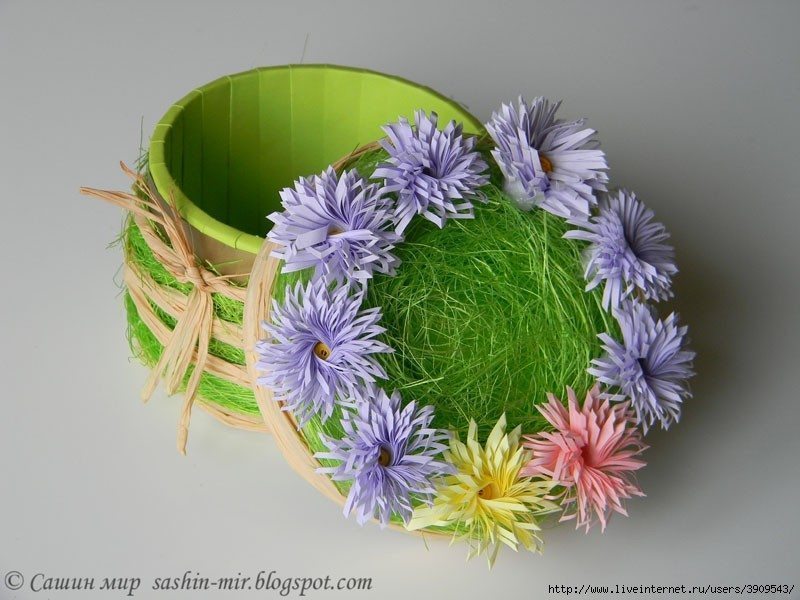

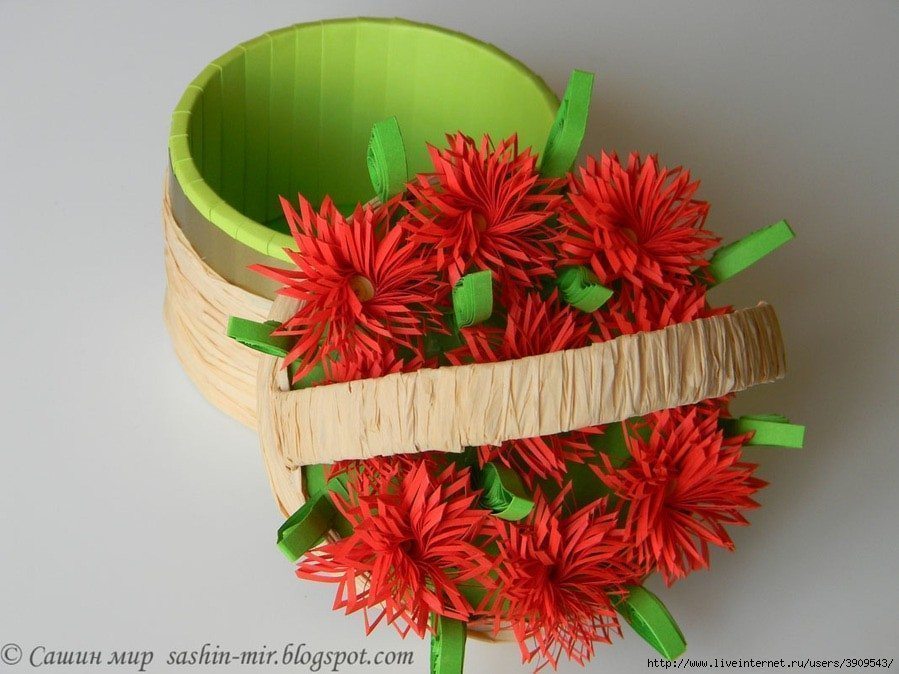
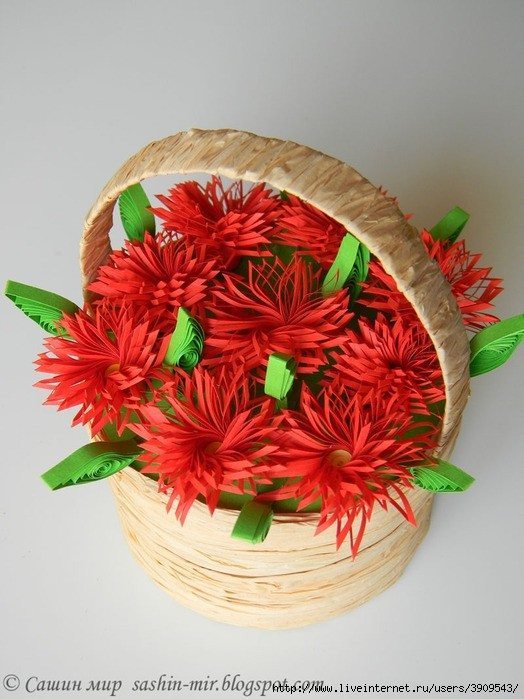
How to make a rose of corrugated paper

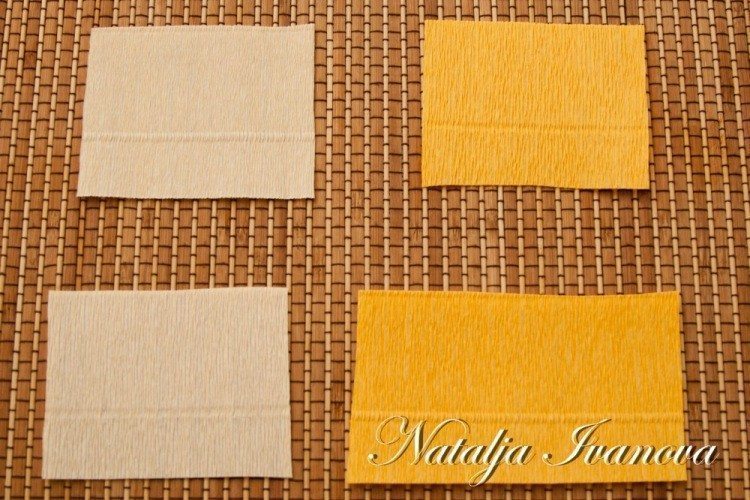
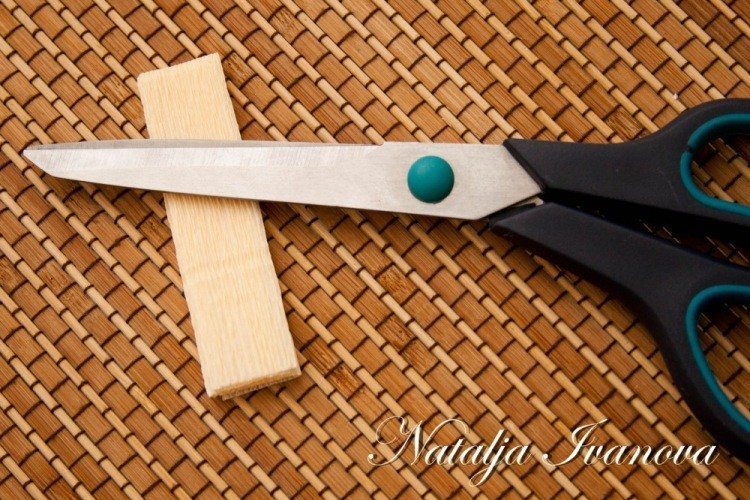

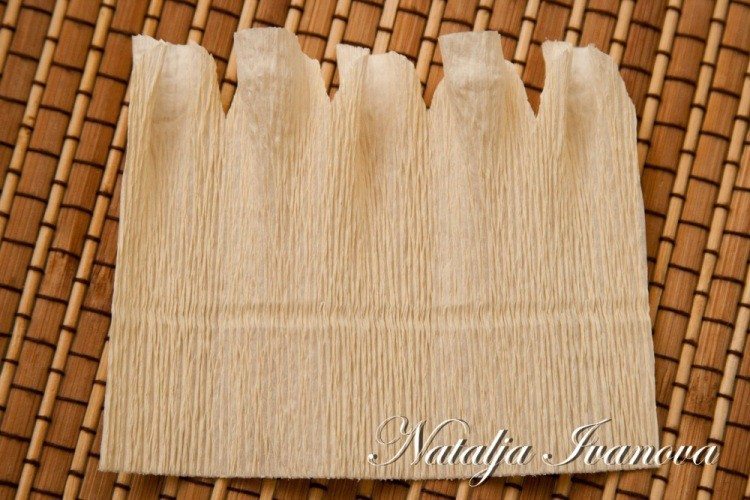
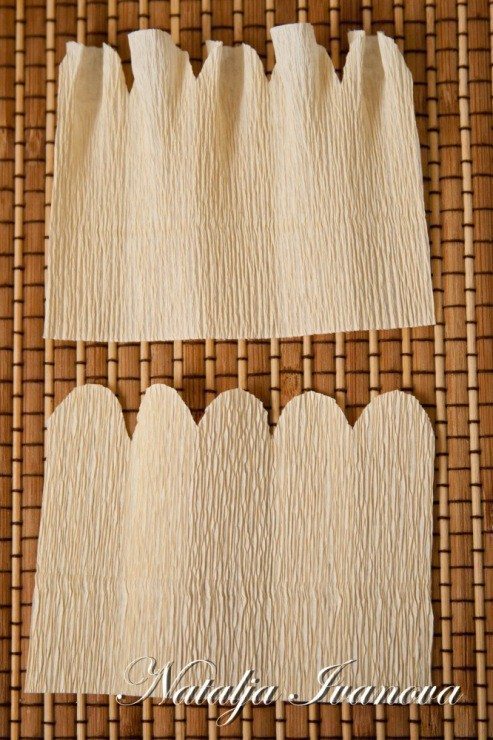
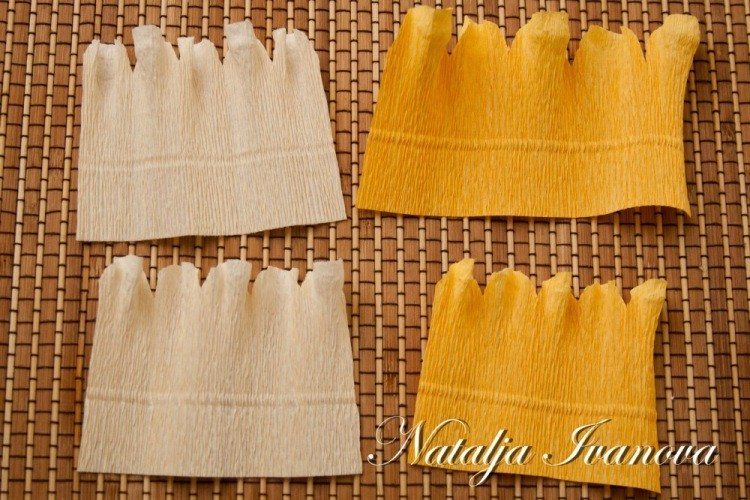
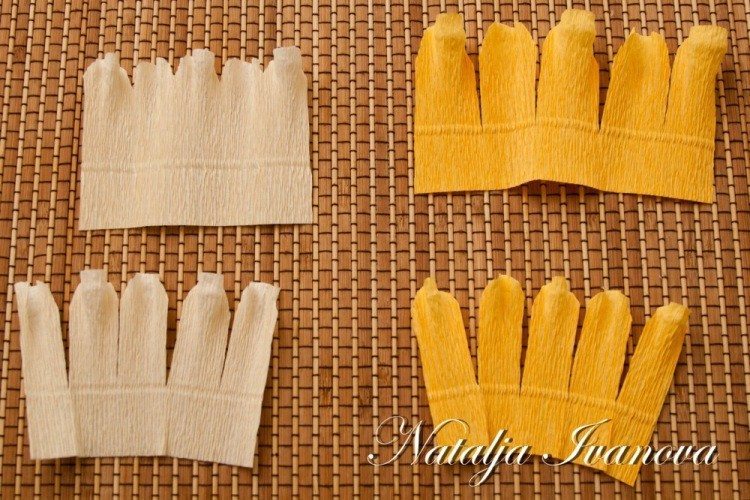
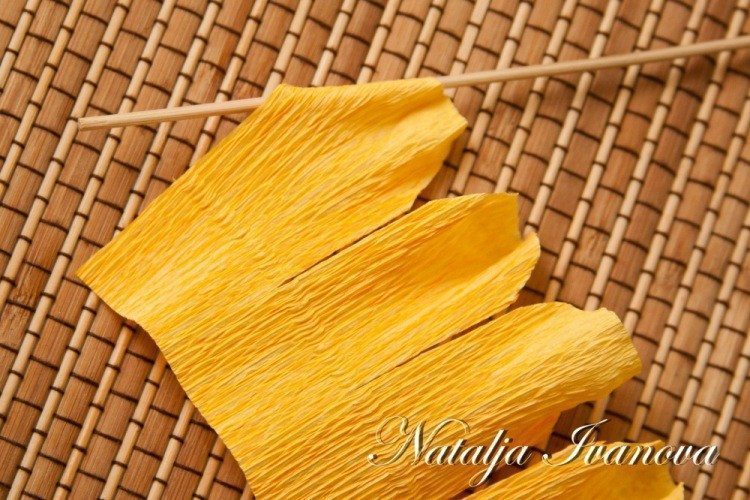
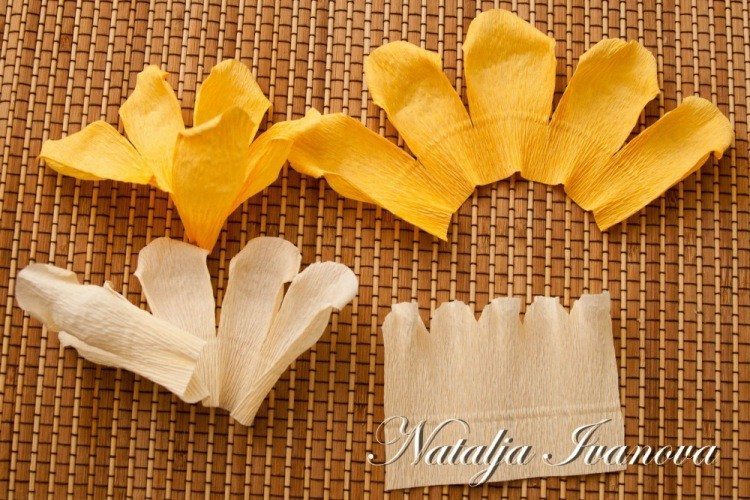

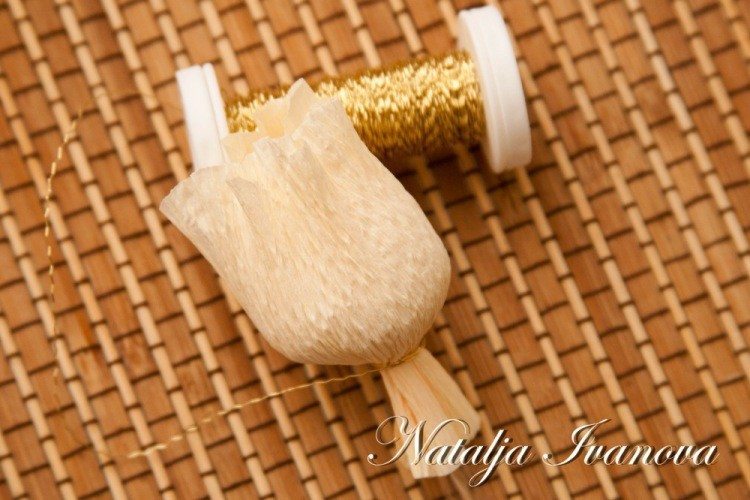

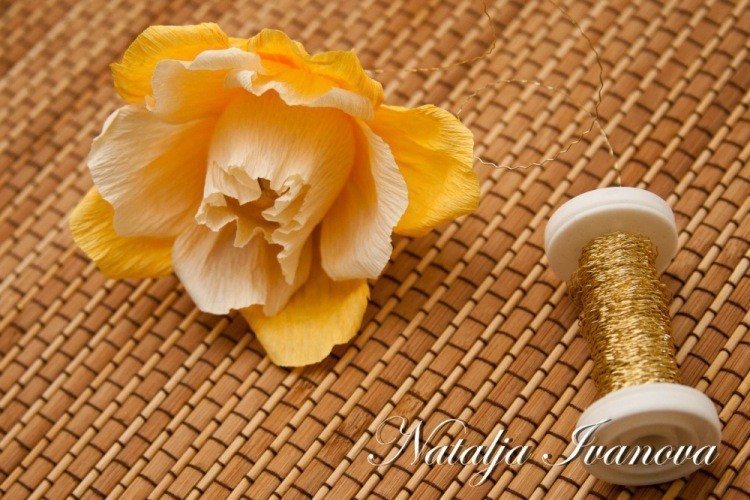
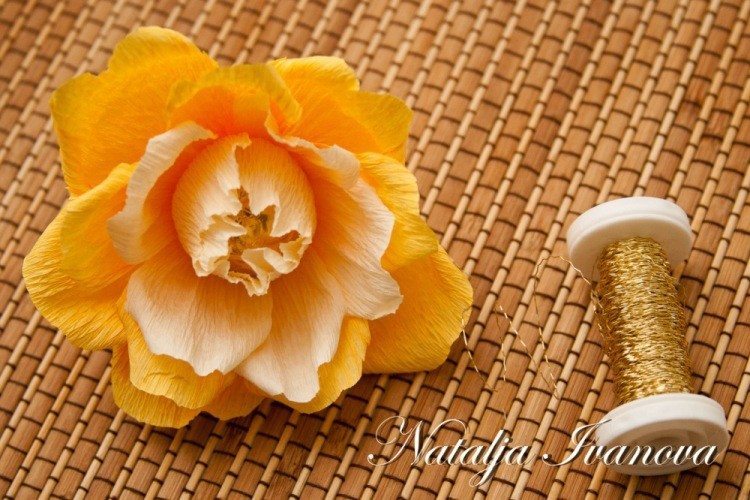
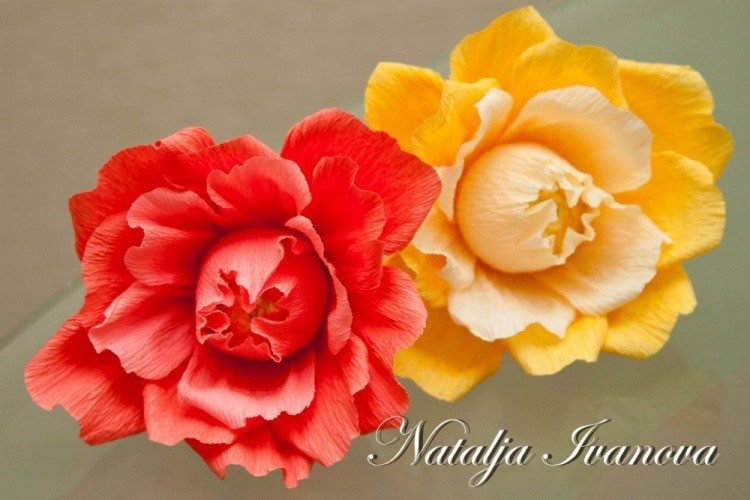
Stash for needlework patchwork
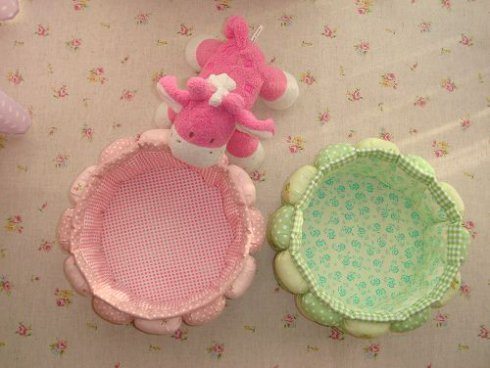


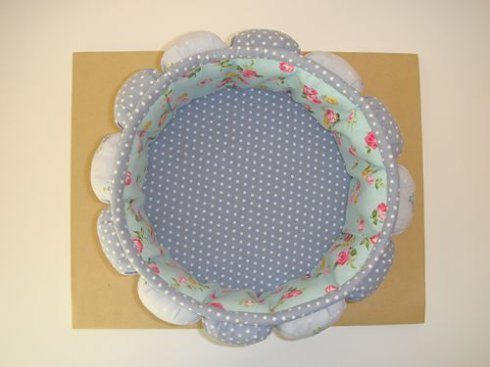
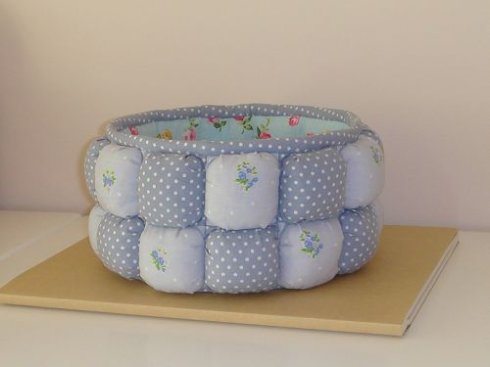
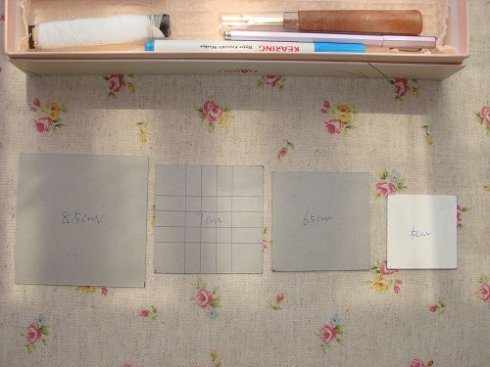
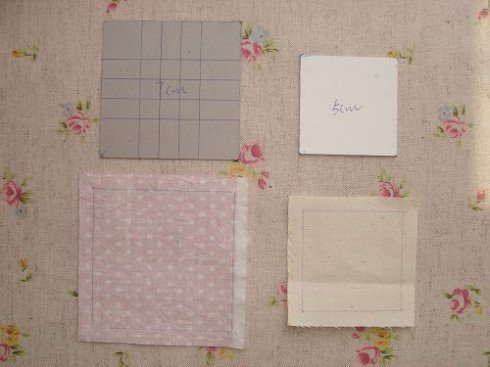
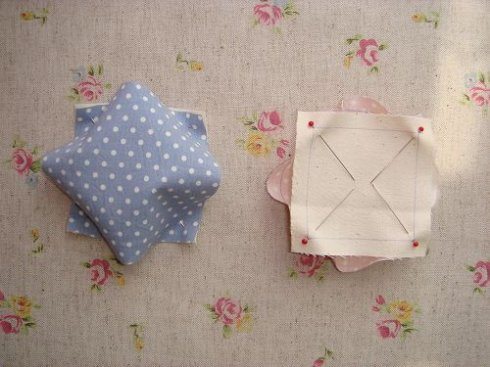
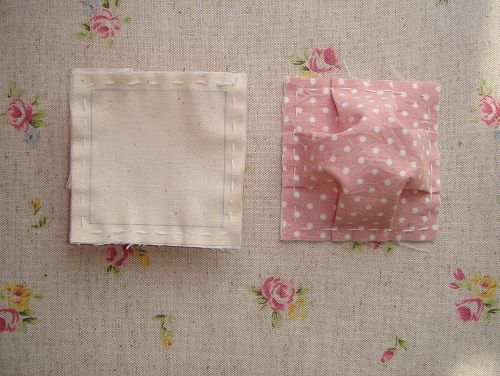
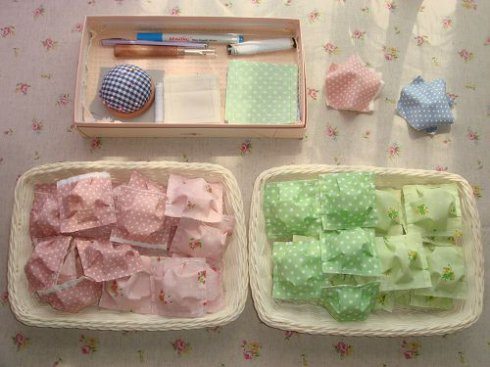
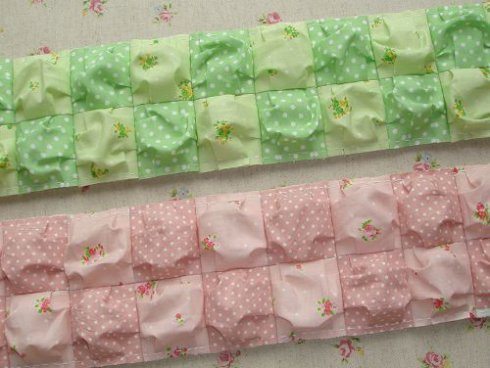


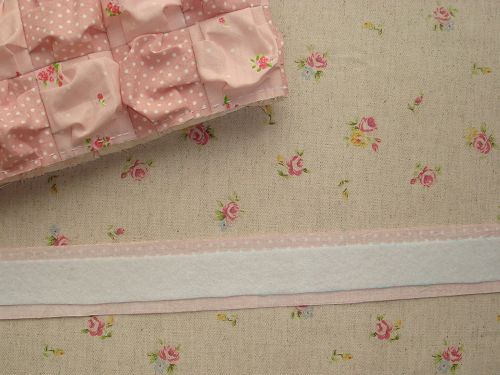


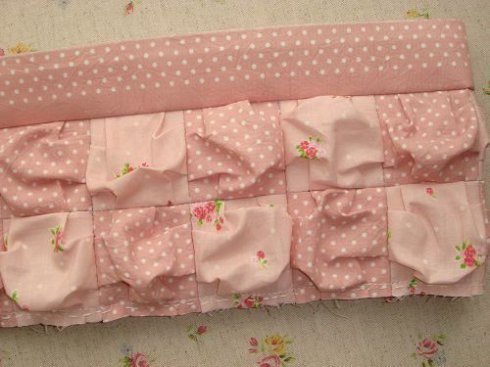
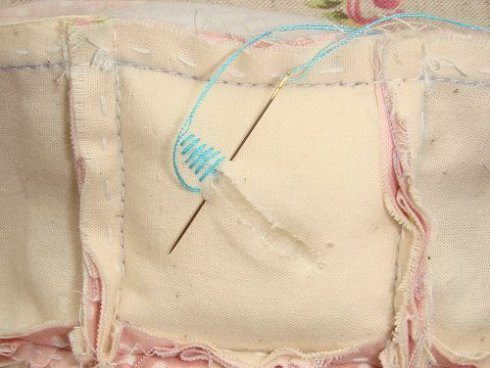

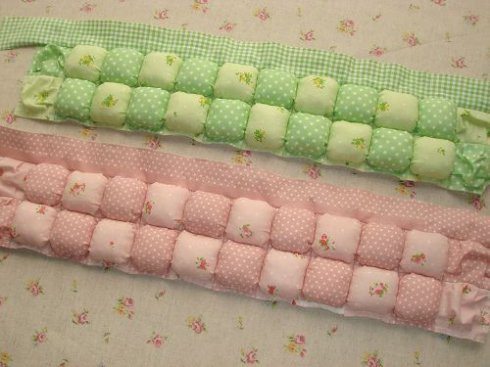
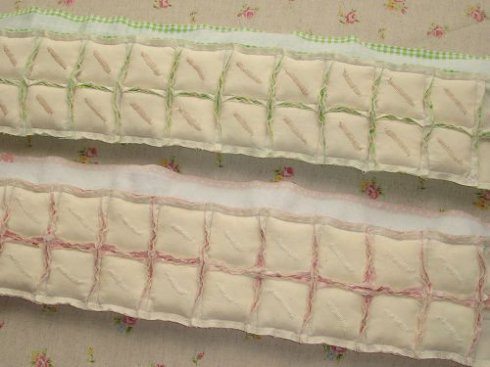
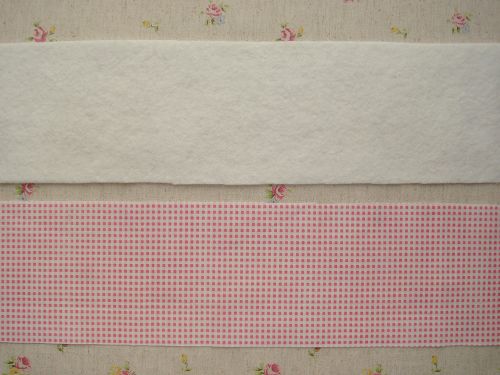

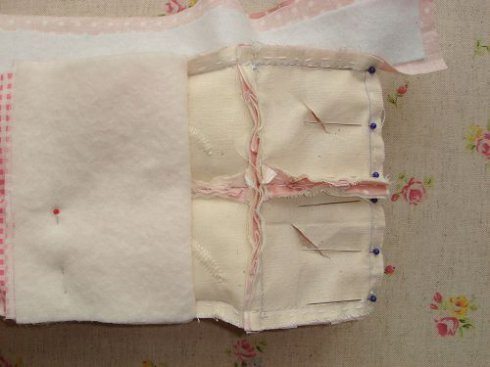
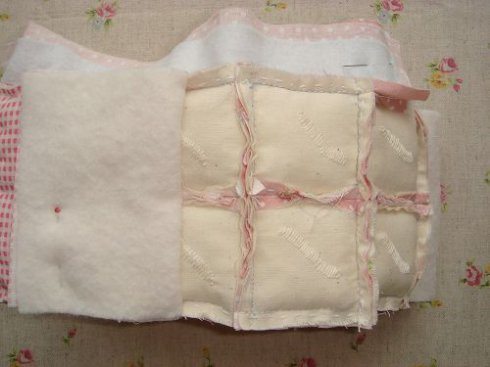
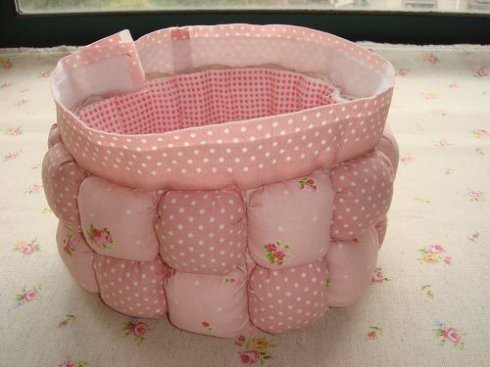
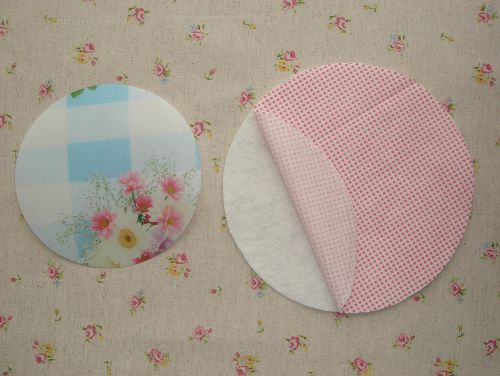
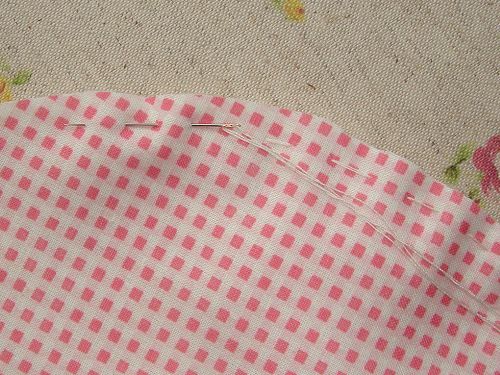

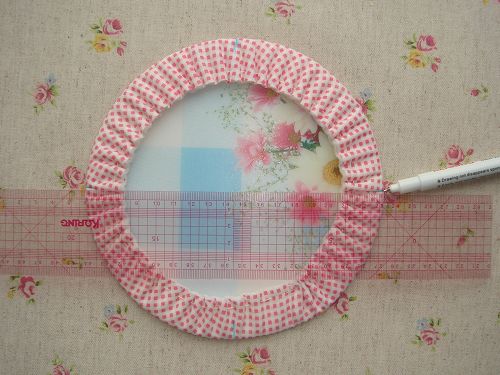
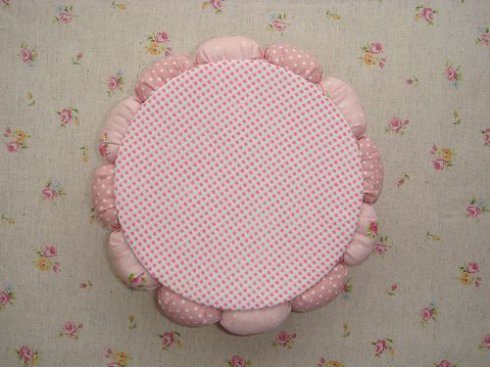

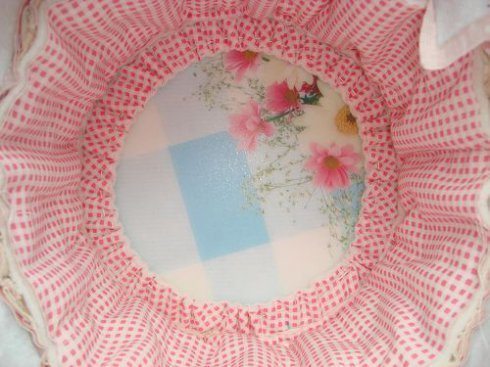
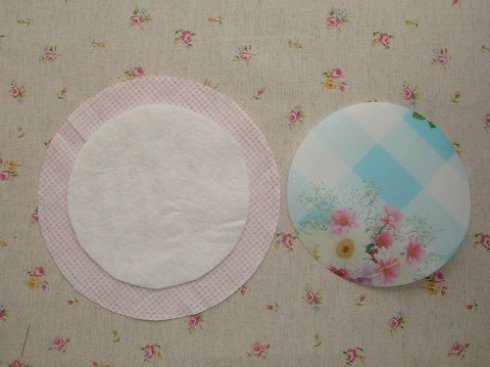
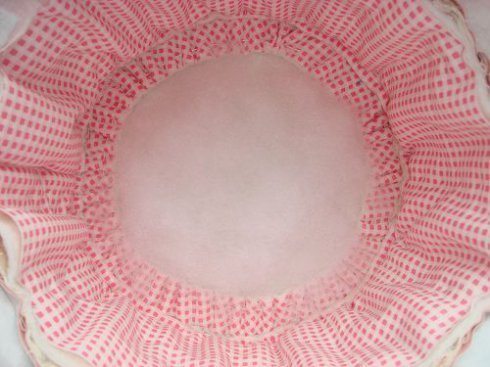

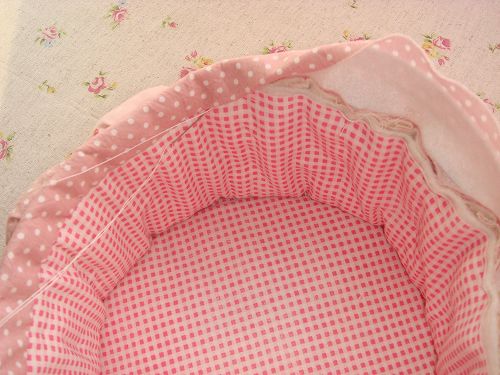
How to decorate flower pot
I had a clay pot – good and solid. But over time, it looks like something appeared unsightly stains, faded paint and I decided to design it in a marine style while combining different techniques.
As a result of my work has appeared here such a handsome man, who serves as the perfect setting my favorite .
Floats on the sea space ship of dreams.
And somewhere at the other end of the world dreams of a beautiful mermaid in the sunset.
Before proceeding to implement the ideas for decorating, I wanted to get rid of the old decor pot of various irregularities and depressions on the surface. For this, I carefully wiped with an alcohol swab pot (thereby degrease it) and missed the wall with white glue, carefully sprinkle the surface of the pot semolina. Munk had to apply two coats, as one layer was not enough to hide the old decor. After semolina dry out, I covered it with clear lacquer in a single layer. The fact that semolina (no matter how well it does not dry out) feature has constantly showered with further her work. I wanted to avoid this and I was pleased to note that the nail perfectly fulfilled its function.
(Unfortunately, I was so fascinated by the process that completely forgot about the step by step photos, so I can not give you the first photos of the pot.) Thus, the surface of the pot is ready – it’s time to decor. Then I turned to the internet, so as absolutely can not draw. I found I liked the coloring of the frigate, to work in Photoshop on its size and printed the ship. Cut out the contour drawing, I put it to the pot and began to translate circuit pattern on the wall of the pot. For this I used the pen and stylus pen just broke through the paper into the ground trace, drawing so directly to Manco. As for the mermaid, her figure, I also found on the internet and decided to transfer the image of a girl on the pot using decoupage. Processed image in Photoshop (size and picture resolution), I pasted on a sheet of A4 (plain, which make a printout) top layer napkins. I previously shared a napkin into 3 layers, it will give me the opportunity to do one of 3 print napkins and nothing goes to waste in vain .. I want to draw your attention that by numerous experiments and tests on an inkjet printer, I came to the conclusion that the size wipes should be slightly smaller than A4. Napkin should stick along the contour is not right to the edges of the sheet, and slightly deviate from them (especially in a place where the printer grabs the sheet at the beginning of the press (about 2 cm). This will allow you to “trick” the printer, and he thinks that directly paper prints and not a napkin. Thus, you can avoid it, “WRINKLE” and breaks. print the image of a mermaid on a napkin, I cut it on a path and attach to the pot. Noting pencil zone to be covered with a printout, I painted it white, gave the paint to dry and proceeded directly to decoupage. Again, referring to the numerous attempts to find their best way of gluing the printed image on the printer to the desired surface, I would say that neither diluted PVA glue for decoupage or are not suitable for this task. they contain water, and she – the worst enemy of printouts. In contact with water colors the printer they “flow”; alas, it was ruined by a few of my ideas, but I found an acceptable solution. This lacquer for furniture (in my case, a colorless, glossy, nitrile). With a printout of the surface of the pot, I coat with a brush to polish the image from the middle to the edges, gently stroking pattern. (I must admit that often have to use your finger, for best results, but it is almost always happy!) Here’s what happened as a result.
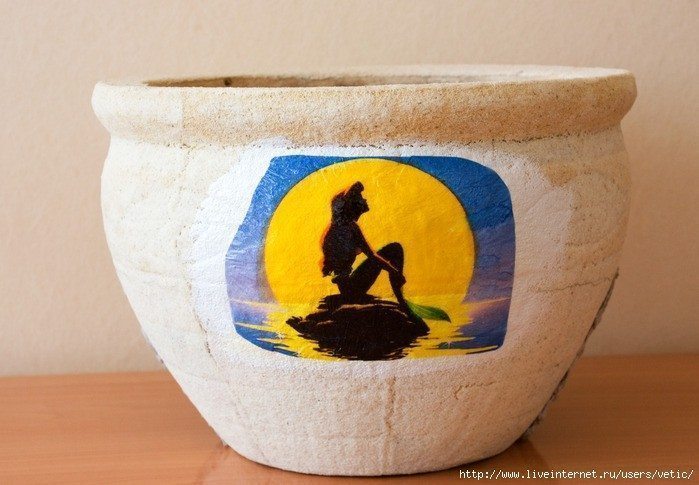 I really wanted to make the surface texture of the pot. Munk gives a lovely texture to the sky, but it seemed to me that it is not quite suitable for simulating waves. Here I decided to try and portray waves using toilet paper and PVA. The technique of using toilet paper, I peeked at one of the masters (sorry, can not remember the name), but they do implement the paste. To me, I confess honestly, it seemed that there is no need to cook the paste in the presence of PVA (I previously bought a large jar of glue at the hardware store). Pouring glue into the bowl, I carefully lowered into it the pieces of toilet paper , slightly rumpled them, squeeze and spread on the walls of the pot. Similarly, shaped and gulls. After the work was finished, I again went through the “wave” brush generously soaking them with glue. Fingernail gives the surface undulations and left to dry pot. For complete drying glue took about 2 days. Here’s how rough the waves look around after drying.
I really wanted to make the surface texture of the pot. Munk gives a lovely texture to the sky, but it seemed to me that it is not quite suitable for simulating waves. Here I decided to try and portray waves using toilet paper and PVA. The technique of using toilet paper, I peeked at one of the masters (sorry, can not remember the name), but they do implement the paste. To me, I confess honestly, it seemed that there is no need to cook the paste in the presence of PVA (I previously bought a large jar of glue at the hardware store). Pouring glue into the bowl, I carefully lowered into it the pieces of toilet paper , slightly rumpled them, squeeze and spread on the walls of the pot. Similarly, shaped and gulls. After the work was finished, I again went through the “wave” brush generously soaking them with glue. Fingernail gives the surface undulations and left to dry pot. For complete drying glue took about 2 days. Here’s how rough the waves look around after drying.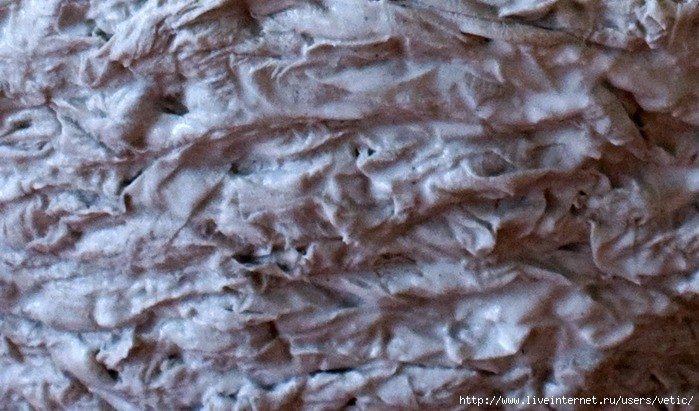


Before you start coloring, I make a rational decision about the colors. Before, I always bought acrylic paint in jars (set or individually), but they had a property very quickly (and usually does not end in time). Constantly buying new is not always possible, and not cheap. This time I decided wisely. At the hardware store I bought a big jar of white acrylic paint and a few cans of tinting pastes of different colors. Now I had the opportunity not only to mix colors, but get different shades of the same color. This is very convenient, fun, interesting, enjoyable and most importantly, all came together much cheaper than acrylic paints of different colors! Now there is no need to run to the store for a desired color or fear that the paint will end out of time !!! I strongly advise craftswomen to use this idea. Spreading in the palette I needed tone and shades, I painted the ship, gave paints dry and started coloring waves. Used 5 colors (blue, blue, steel, white, green and azure). Each shade is applied on certain parts of the paper invoice (bulges or depressions), the next color – after the previous one has dried.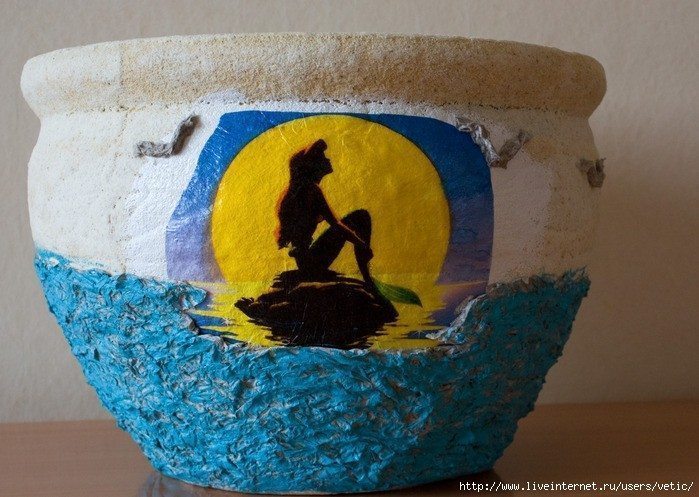
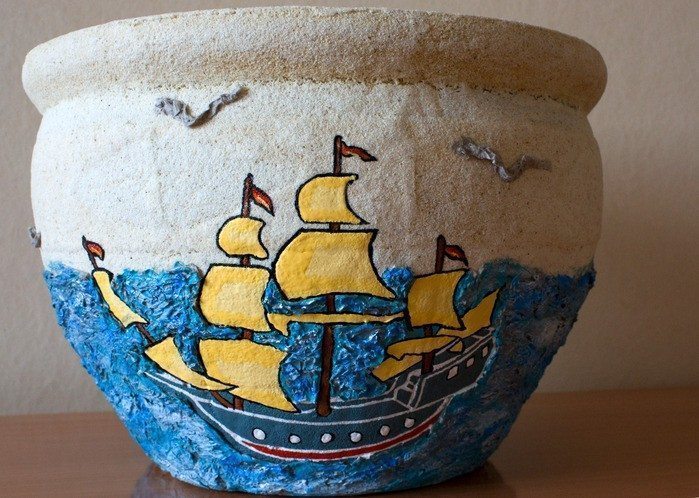
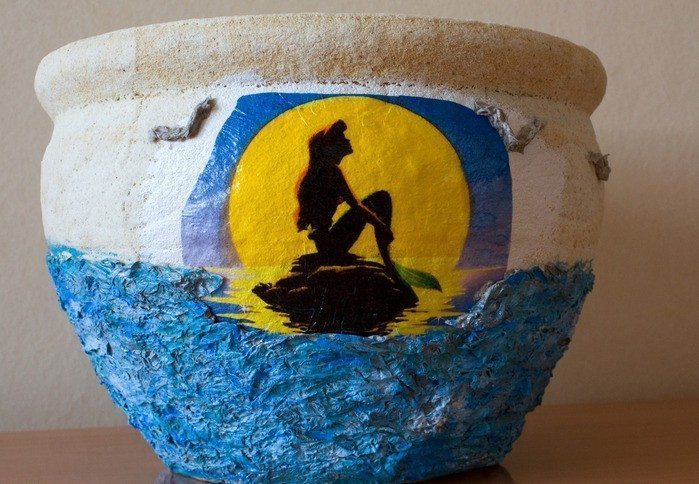
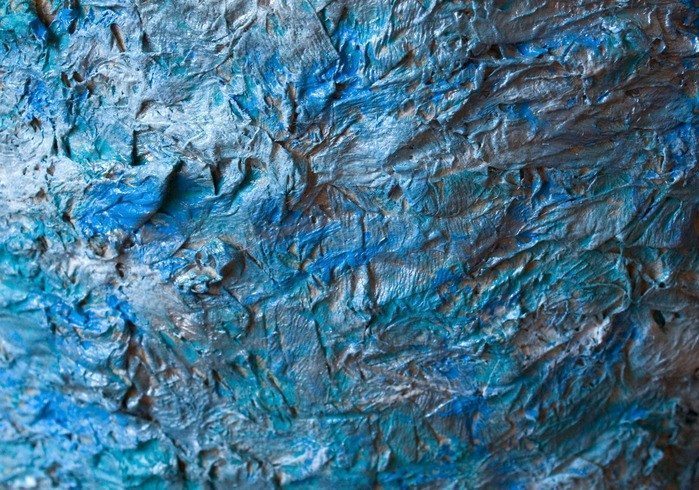 Pick the right colors
Pick the right colors
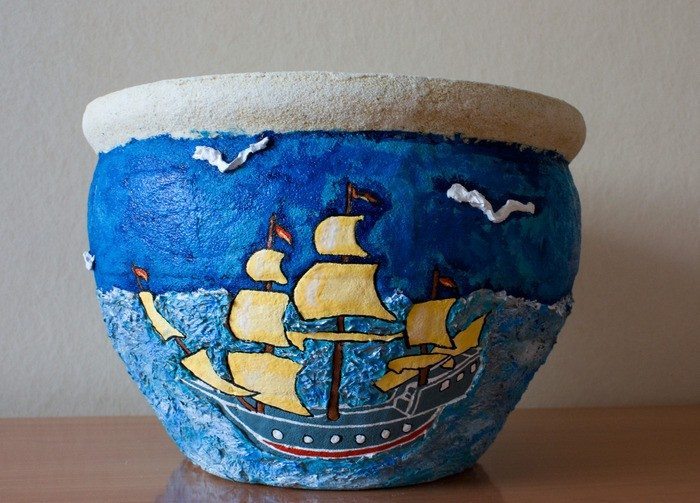
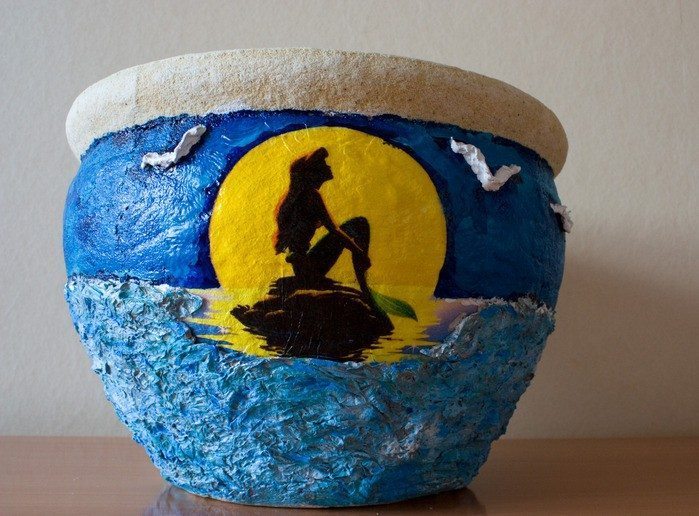
Finishing Touches: Rim of the pot, I decided to paint in white and lightly shade the twine (something like hemp to simulate old frigate). Decorative edging silver stylized ropes that hold the sails.
Mermaid I wanted to set off the golden sequins (like the glow of the setting sun).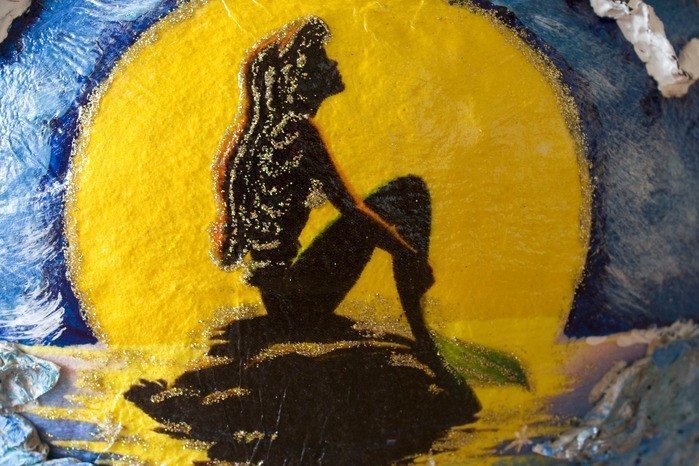
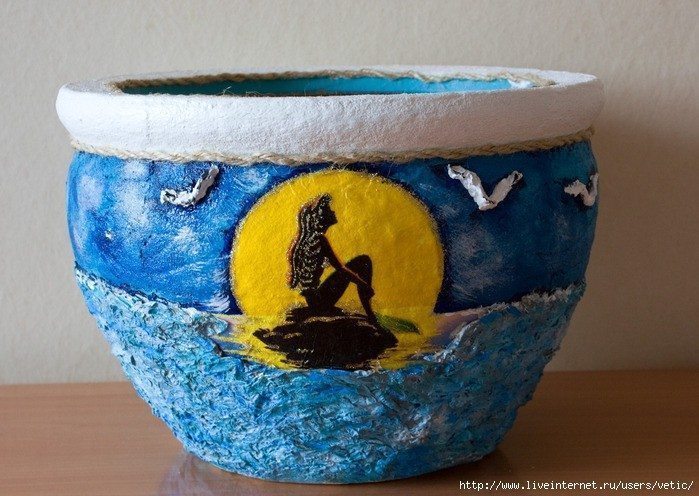 Finally, I covered the pot with two layers of varnish.
Finally, I covered the pot with two layers of varnish.
Beautiful Crochet Yarn Flower
This Crochet Yarn Flower is easy to make and pretty for Spring. Dandelion is beautiful, strong and resilient, and now crochet one for your home for spring decoration, look fresh, right? This dandelion flower itself is easy to make, and you can use classic pom pom techniques to create, but I prefer this way below by cutting into two. And there is a way to make if you don’t have U crochet hook by using fork and green pipe cleans instead.
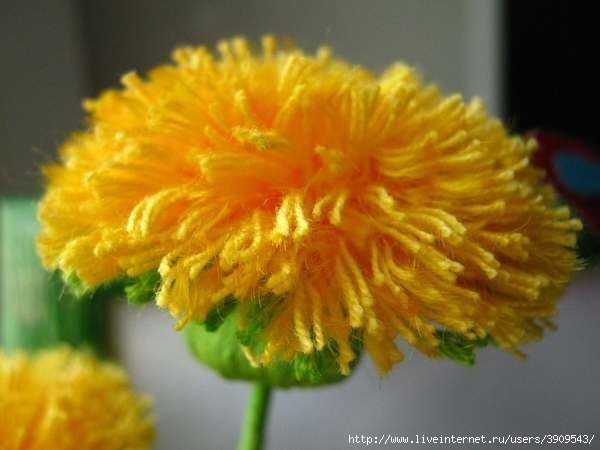
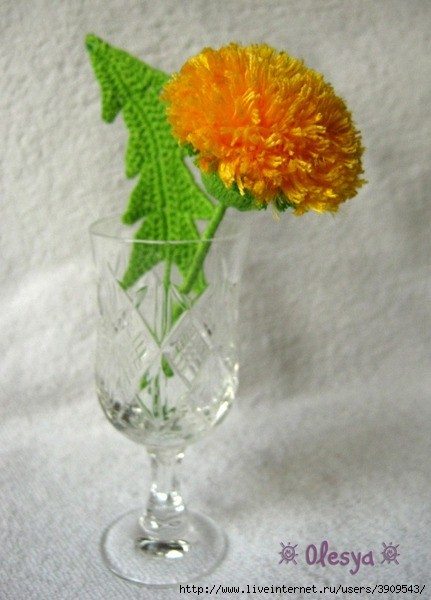
Required Materials:
- Yarn (Green and Yellow)
- Crochet hooks
- Wire
- Needle and thread
- Glue
- Scissors
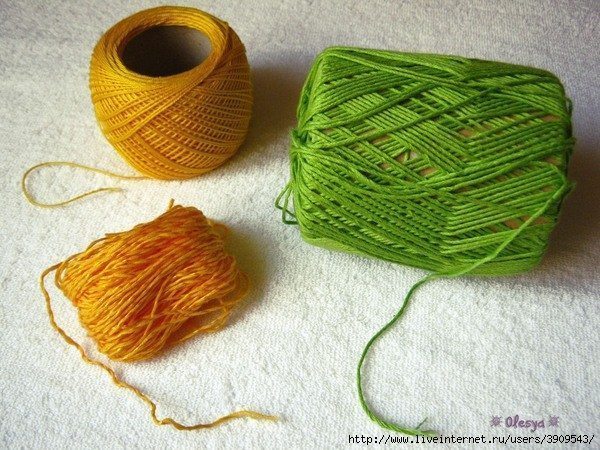
Steps:
To make a dandelion first you have to wrap yellow yarn around a U shape crochet hook. After that pass yarn from the middle along its width, apply glue and and roll it.
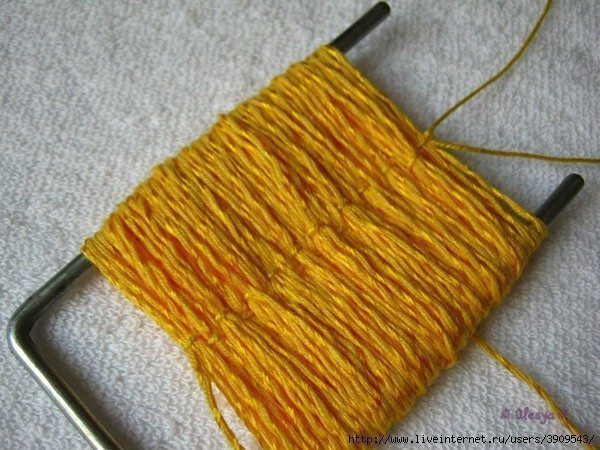
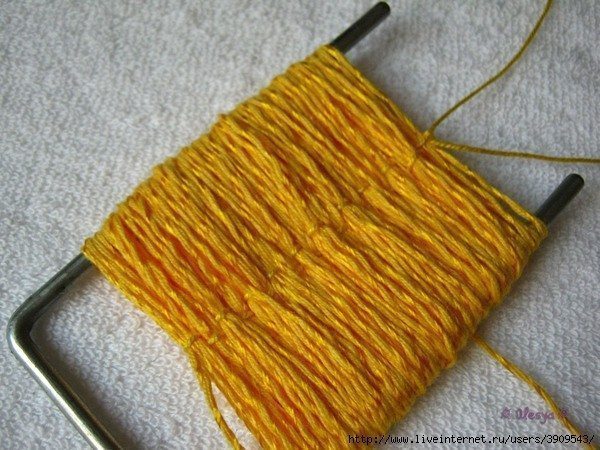

Wrap yarn around the center of the yarn roll and cut it in two pieces to get two pom poms.
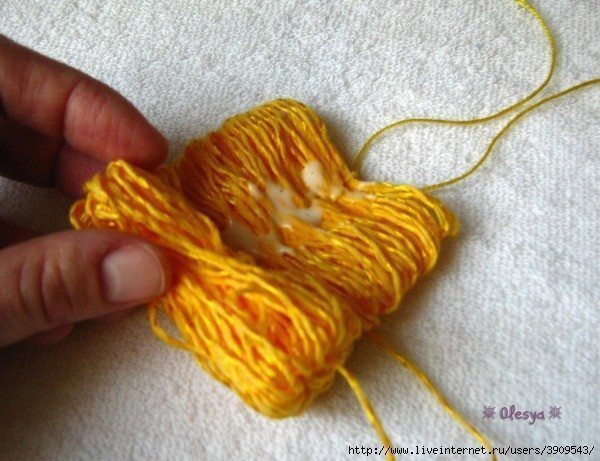
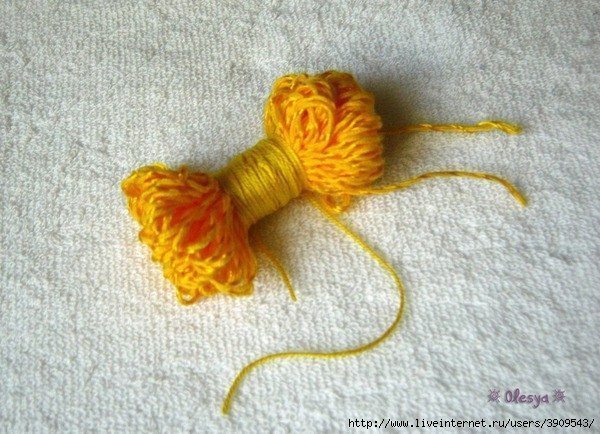
Wrap this patch around the dandelion top and tie it. Tie the lower part tightly and cut the edge. Dip in white glue to seal.

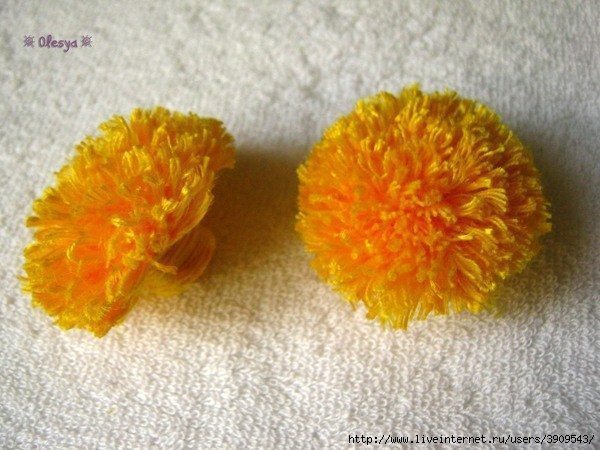
Then cut pieces of green yarn in equal length and thread a green thread through each piece of yarn with needle. Again repeat the same step with some gap.
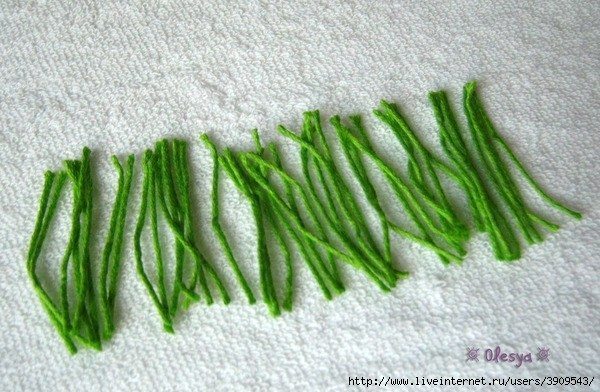
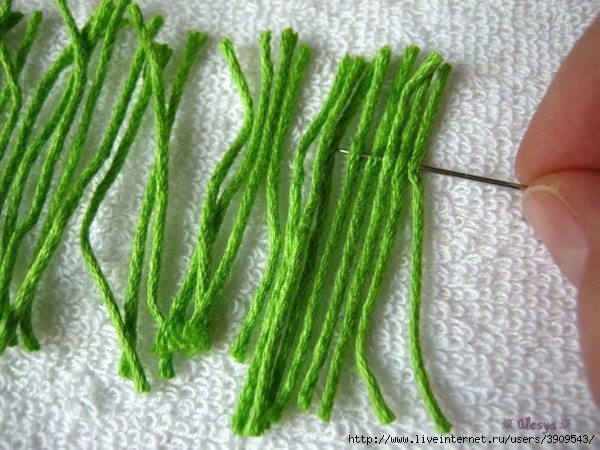
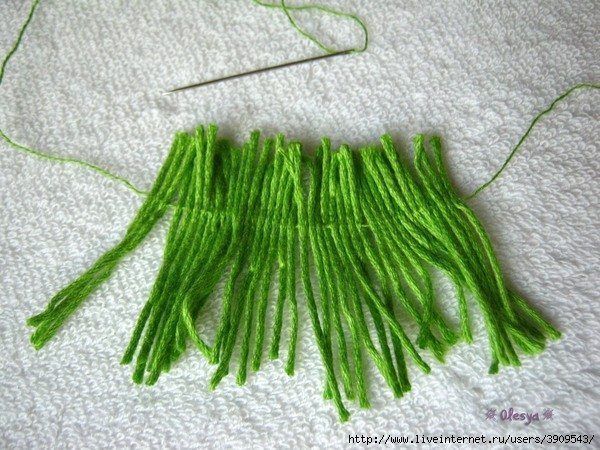
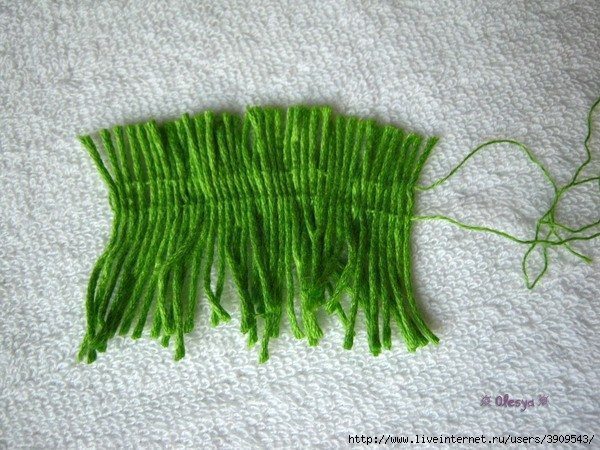
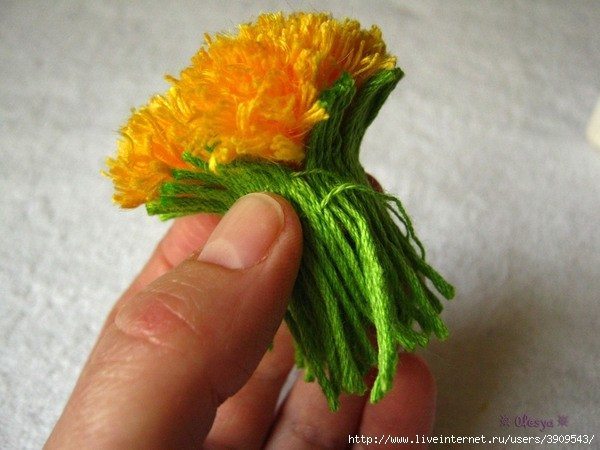

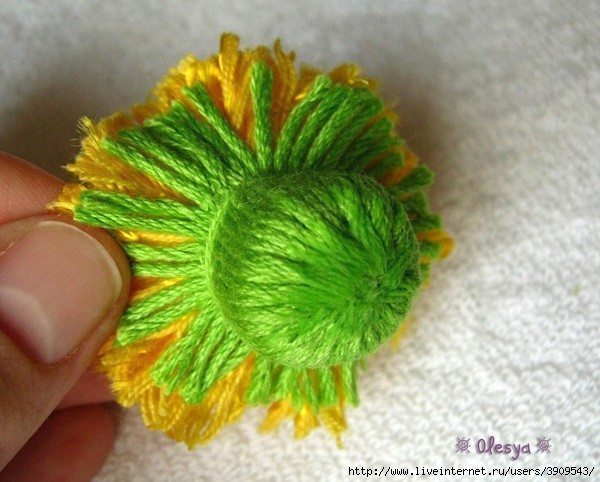
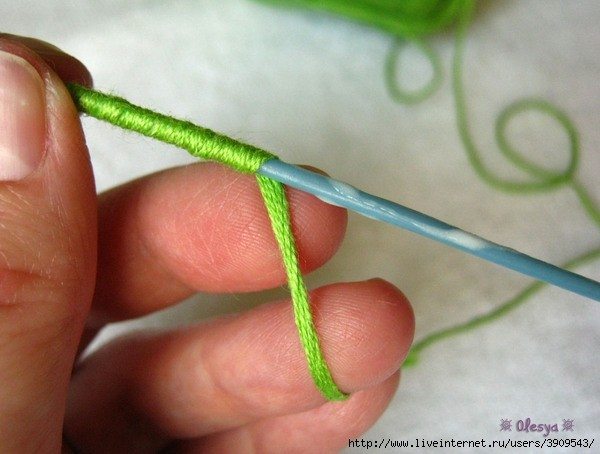
Cover a stick of plastic with green yarn by applying glue and hot glue the dandelion to it. Make more and complete a bunch.
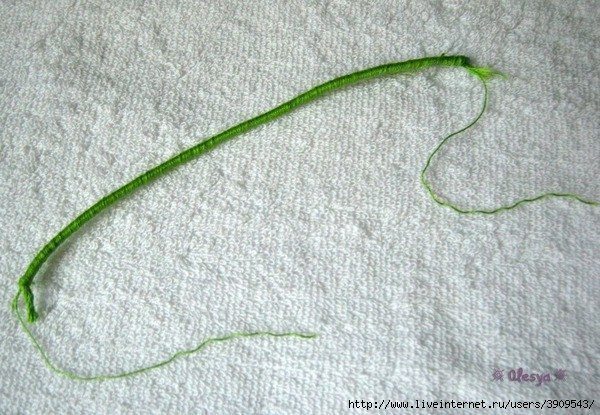
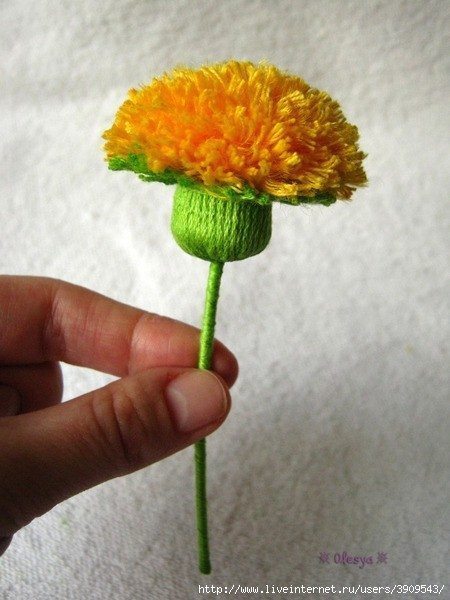

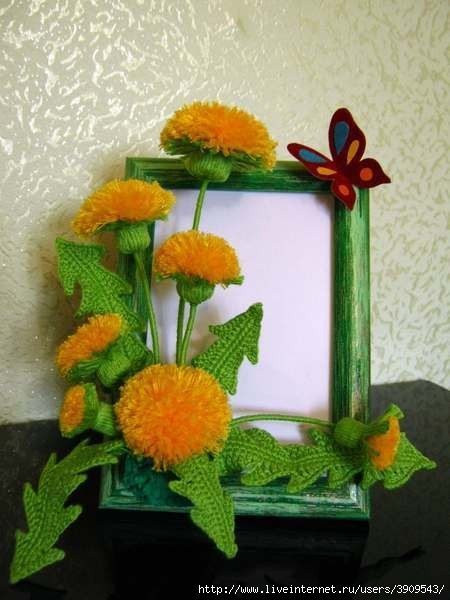
Hope you like this Crochet yarn Flower tutorial.
We would love to hear your thoughts in the comment section below. And be sure to like us Facebook for more ideas!
Thank you for visiting our website. Keep Creating with Art & Craft!
